COVID-19 in Canada: A One-year Update on Social and Economic Impacts
Archived Content
Information identified as archived is provided for reference, research or recordkeeping purposes. It is not subject to the Government of Canada Web Standards and has not been altered or updated since it was archived. Please "contact us" to request a format other than those available.
Skip to text
Text begins
Foreword

Anil Arora
Chief Statistician of Canada
This past year has presented incredible challenges and inflicted untold grief on so many in Canada and around the world. It has also shown our resilience and our ability to step up, to adapt, and to be innovative. Providing a solid fact base and enabling decisions that impact lives and livelihoods have been the driving force for each of us at Statistics Canada.
I am so thankful to our partners, stakeholders and Canadians who have participated in our survey programs and shared data to allow us, as a society, to find out sooner and act faster during this crisis. I am especially proud of my colleagues within the agency who have time and time again proven that this hundred-year institution can be innovative, agile, and responsive, and can provide independent, trustworthy and timely data and insights. I thank them for digging deeper and for their sacrifices and expertise over this past year.
I am pleased to provide a snapshot of what our society and economy have faced this past year, in the form of this year-in-review compendium COVID-19 in Canada: A One-year Update on Social and Economic Impacts. I encourage you to visit our website for more detailed information, our analysis series, dashboards and the Canadian Statistical Geospatial Explorer. Let's use these data to garner insights that will help us build back better.
Thank you.

The situation
- Canadians continue to respond to COVID-19
- Canadians following public health practices but vaccine hesitancy could be an issue.
- Indirect health impacts of COVID-19
- Indirect impacts including on mortality, cancer and mental health could have a lasting effect on Canadians.
- Uneven social and economic impacts of COVID-19
- Uneven impacts could threaten greater social and economic inequalities.
- Economic impacts: Assessing the recovery
- How much is temporary and how much will be structural change.
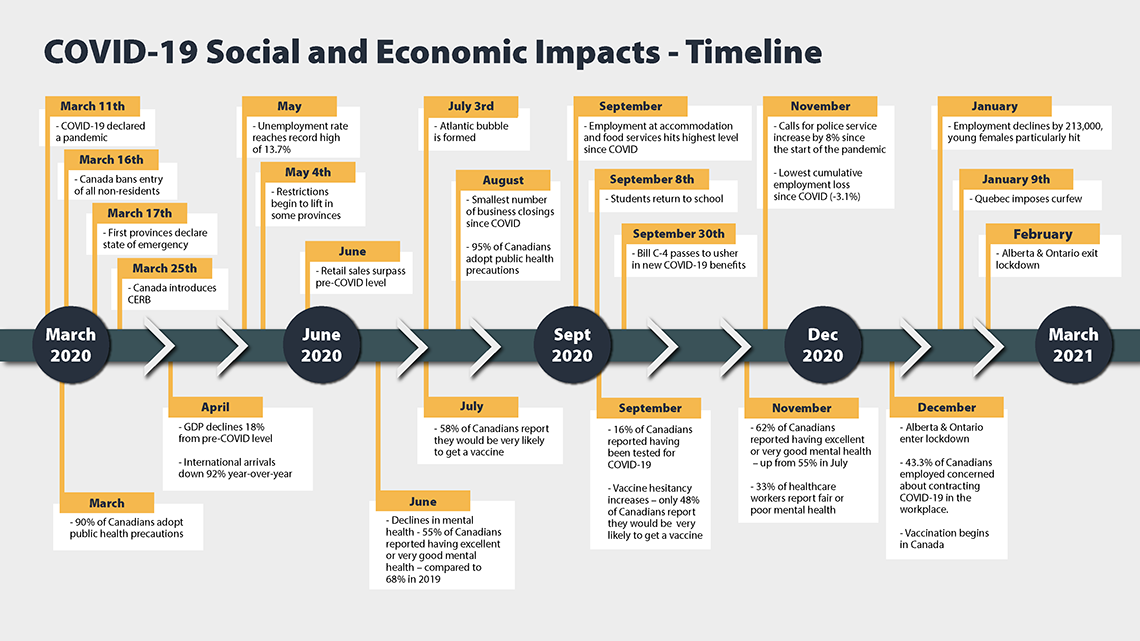
Description for Figure 1
The title of the image is “COVID-19 Social and Economic Impacts – Timeline.”
The image presents a timeline of the social and economic impacts of the COVID-19 pandemic from March 2020 to March 2021.
The background of the image is light grey. At the top of it appears the title “COVID-19 Social and Economic Impacts – Timeline” in a large, black, bolded font. The timeline starts from the left side of the image and ends on the right side of it. It is represented by a large, dark grey horizontal band situated in the middle of the image. On this horizontal band, five black circles appear, at equal distance. The circles are wider than the horizontal band. In each circle appears the name of a month and year in a white bolded font. From left to right, the months and years appear as follows: “March 2020,” “June 2020,” “Sept 2020,” “Dec 2020,” “March 2021.” On the same horizontal band, in the space between each pair of black circles, two large light grey arrowheads appear, their sides going beyond the horizontal band. There are eight arrowheads in total. The arrowheads are equally distanced and are all pointing to the right side of the image: they indicate the direction of the timeline (from March 2020 to March 2021).
Starting from the large, dark grey horizontal band are 16 vertical leader lines that extend to the top portion of the image and 7 vertical leader lines that extend to the bottom portion of the image. The leader lines are of the same narrow width and of a light brown shade. They are of different lengths. At the end of the leader lines begin wider horizontal lines of the same colour but of different widths and lengths. These horizontal lines are banners that all extend to the right of their respective vertical leader line. In the banners, dates are written in small, bolded black font. The top of a white rectangle is attached to each banner. In this rectangle, a timeline event is described. The events are linked to their respective banner and leader line to the large, dark grey horizontal band in the chronological order indicated on the band.
The 16 dates and events in the top portion of the figure are as follows, starting from March 2020: March 11th, COVID-19 declared a pandemic; March 16th, Canada bans entry of all non-residents; March 17th, First provinces declare state of emergency; March 25th, Canada introduces CERB; May, Unemployment rate reaches record high of 13.7%; May 4th, Restrictions begin to lift in some provinces; June, Retail sales surpass pre-COVID level; July 3rd, Atlantic bubble is formed; August, Smallest number of business closings since COVID, 95% of Canadians adopt public health precautions; September, Employment at accommodation and food services hits highest level since COVID; September 8th, Students return to school; September 30th, Bill C-4 passes to usher in new COVID-19 benefits; November, Calls for police service increase by 8% since the start of the pandemic, Lowest cumulative employment loss since COVID (3.1%); January, Employment declines by 213,000, young females particularly hit; January 9th, Quebec imposes curfew; February, Alberta and Ontario exit lockdown.
The 7 dates and events in the bottom portion of the figure are as follows, starting from March 2020: March, 90% of Canadians adopt public health precautions; April, GDP declines 18% from pre-COVID level, International arrivals down 92% year-over-year; June, Declines in mental health—55% of Canadians reported having excellent or very good mental health—compared to 68% in 2019; July, 58% of Canadians report they would be very likely to get a vaccine; September, 16% of Canadians reported having been tested for COVID-19, Vaccine hesitancy increases—only 48% of Canadians report they would be very likely to get a vaccine; November, 62% of Canadians reported having excellent or very good mental health—up from 55% in July, 33% of healthcare workers report fair or poor mental health; December, Alberta and Ontario enter lockdown, 43.3% of Canadians employed concerned about contracting COVID-19 in the workplace, Vaccination begins in Canada.
Canadians continue to respond to COVID-19
Canadians continue to support public health measures
- During the first half of the pandemic, the majority of Canadians (90%) took precautions such as physical distancing and wearing masks to reduce cases of illness and to avoid overwhelming the health care system.
- By September, over 95% of Canadians indicated that they were taking precautions such as washing hands, wearing a mask and maintaining physical distance.
- Results were fairly consistent across population groups, including gender, age and visible minority groups.
- By contrast, 67% of individuals reported that they avoided leaving the house for non-essential reasons.

Data table
| Percent | |
|---|---|
| Washes hands more frequently | 96.1 |
| Wears a mask in public places | 96.5 |
| Keeps a 2 m / 6 ft distance from others | 94.8 |
| Avoids crowds / large gatherings | 93.1 |
| Avoids leaving house for non-essential reasons | 67.0 |
| Works from home (paid worker) | 37.8 |
| Uses delivery / curb side pick-up services | 40.3 |
| Self-isolates if they have symptoms | 66.3 |
| Source: Canadian Community Health Survey, September 2020 provisional data. | |
Compliance is higher among those who experienced symptoms
- By September, 12% of Canadians reported having experienced symptoms related to COVID-19 (i.e., fever, cough, chills, difficulty breathing, fatigue) since the start of the pandemic.
- Rates were higher among young adults aged 15 to 24 years (18.5%), compared with those aged 65 years and older (7%).
- Among these individuals, 93% said they followed public health recommendations such as self-isolating and wearing a mask if going out while experiencing symptoms.
- In September, 16% of Canadians reported having been tested for COVID-19 using a deep nasal or throat swab.
- Among them, 2% indicated that they tested positive and 3% were still waiting for test results.

Data table
| Percent | |
|---|---|
| Male | 13.2 |
| Female | 10.9 |
| 15 to 24 years | 18.5 |
| 25 to 44 years | 14.5 |
| 45 to 64 years | 10.9 |
| 65 years and older | 6.9 |
| Grade 13 graduate or less or some postsecondary education | 6.4 |
| Trades, community college, CEGEP, or university certificate below bachelor's degree | 12.6 |
| Bachelor's degree (reference group) | 15.2 |
| Above bachelor's degree | 11.6 |
| Born in Canada | 13.7 |
| Landed immigrant | 7.7 |
| White | 12.9 |
| Visible minority | 10.3 |
| Source: Canadian Community Health Survey, September 2020 provisional data. | |
Optimism increases as vaccination begins
- COVID-19 vaccination in Canada began the week of December 13, 2020.
- As recommended by the National Advisory Committee on Immunization, vaccination was focused on priority groups including adults aged 80 years and older, health care workers, and adults living in senior care.
- As of March 5, the proportion having received at least one dose of the vaccine among these groups was 18.96%, 52.80% and 85.29% respectively.
Source: Government of Canada; https://health-infobase.canada.ca/covid-19/vaccination-coverage/#a3
Despite optimism, fewer Canadians are very likely to get a COVID-19 vaccine
- Early in the pandemic, 58% of people were very likely to get a vaccine (July 2020)—this dropped to 48% in September 2020.
- By contrast, 49% of Canadians were not very likelyNote to get a vaccine. Less likely to get a vaccine were
- those aged 25 to 44 (56%)
- those with a grade 13 education or less or some postsecondary education (64%)
- Black Canadians (77%).

Data table
| Percent | |
|---|---|
| White only | 51.0 |
| South Asian only | 51.7 |
| Chinese only | 50.9 |
| Black only | 76.7 |
| Filipino only | 58.2 |
| Latin American only | 66.4 |
| Arab only | 53.3 |
| Southeast Asian only | 55.9 |
| Grade 13 graduate or less or some postsecondary education | 63.6 |
| Trades, community college, CEGEP, or university certificate below bachelor's degree | 56.2 |
| Bachelor's degree | 37.4 |
| Above bachelor's degree | 37.0 |
| 15 to 24 years | 51.0 |
| 25 to 44 years | 56.2 |
| 45 to 64 years | 48.4 |
| 65 years and older | 46.0 |
| Male | 49.6 |
| Female | 53.6 |
|
Note: “Not very likely” includes response categories indicating “somewhat likely,” “somewhat unlikely,” “very unlikely,” and “don’t know.” Source: Canadian Community Health Survey, September 2020 provisional data. |
|
Vaccination will be critical to protect essential health care workers, among whom visible minority groups are overrepresented
- The proportion of immigrants employed as nurse aides, orderlies and patient service associates rose from 22% to 36% between 1996 and 2016.
- Before the pandemic, visible minorities were overrepresented in these occupations—34% of workers identified as visible minorities, compared with 21% in all other occupations.
- This trend has continued during the pandemic—in January 2021, 20% of employed Filipino Canadians and 19% of employed Black Canadians worked in the health care and social assistance industry, compared with 14% of all workers.
| Estimate (%) | |
|---|---|
| All workers | 14.0 |
| Visible minority | |
| South Asian | 12.7 |
| Chinese | 9.9 |
| Black | 19.3 |
| Filipino | 20.4 |
| Arab | 8.7Note E: Use with caution |
| Latin American | 12.9Note E: Use with caution |
| Southeast Asian | 13.3Note E: Use with caution |
| Not Indigenous or a visible minority | 13.8 |
|
E use with caution CV greater than 16.5% when used with the symbol E. Notes: Estimates are for the population aged 15 to 69 and are not seasonally adjusted. Due to the sample size of the Labour Force Survey Supplement, high quality data are only available for the seven largest population groups designated as a visible minority as well as Canadians who do not identify as Indigenous and are not a visible minority when disaggregated. Source: Statistics Canada, Labour Force Survey Supplement, January 2021. |
|
Fear of COVID-19 higher among those who cannot work from home
- In January 2021, more than two-fifths of Canadians (43.3%) who were employed or wanted to work were concerned about contracting COVID-19 in the workplace.
- This was down slightly (-1.8%) from November, when the question was first asked of the entire Labour Force Survey sample.
- Concern remained highest among those with limited opportunities to work from home, including current and recent workers in
- health care and social assistance (57.8%)
- educational services (54.8%)
- retail trade (49.9%), transportation and warehousing (47.0%), and accommodation and food services (46.5%) (not seasonally adjusted).

Data table
| Percent | |
|---|---|
| Agriculture | 16.5 |
| Forestry, fishing, mining, quarrying, oil and gas | 30.1 |
| Utilities | 34.5 |
| Construction | 37.9 |
| Manufacturing | 43.1 |
| Wholesale trade | 39.6 |
| Retail trade | 49.9 |
| Transportation and warehousing | 47.0 |
| Finance, insurance, real estate, rental and leasing | 37.6 |
| Professional, scientific and technical services | 32.3 |
| Business, building and other support services | 39.3 |
| Educational services | 54.8 |
| Health care and social assistance | 57.8 |
| Information, culture and recreation | 38.9 |
| Accommodation and food services | 46.5 |
| Other services (except public administration) | 38.2 |
| Public administration | 41.3 |
| Source: Statistics Canada, Labour Force Survey Supplement, January 2021. | |
Correctional services have reduced custodial populations during the pandemic
- While balancing public safety concerns, correctional institutions have taken steps to lessen public health risks associated with COVID-19 by reducing the number of people held in custody.
- Compared with February 2020, the average daily count of adults in federal, provincial and territorial custody was down 16% by April and 19% by June. Historically, monthly changes in counts are rarely more than 1%.
- From February to June 2020, the average count of adults in federal custody declined by 5%, whereas counts were down by more than one-quarter (28%) for provincial and territorial custody.
- As of February 17, 2021, there were 1,304 positive cases among inmates in federal correctional institutions. Of these cases, most had recovered (95%), while there were still some active cases (4%) and five deaths.

Data table
| 2019 | 2020 | |
|---|---|---|
| average daily count | ||
| February | 37,967 | 37,976 |
| March | 38,314 | 36,960 |
| April | 38,484 | 31,901 |
| May | 38,194 | 30,795 |
| June | 38,070 | 30,580 |
|
Source: Statistics Canada, Canadian Centre for Justice and Community Safety Statistics, Adult Corrections Key Indicator Report, Daily article. |
||
Want to know more?
To learn more about how Canadians responded to COVID-19 early in the pandemic, see Changes in Canadians’ Concerns and Response to COVID-19 in The Social and Economic Impacts of COVID-19: A Six-month Update.
Related articles:
Contributing to front line efforts to tackle COVID-19

A few weeks into the pandemic, Statistics Canada established a repository to help manage the nation’s Personal Protective Equipment inventories (PPE).
Our expertise in epidemiological modelling and demand forecasting quickly helped decision makers make informed choices regarding the needs and distribution for gloves, gowns, respirators and masks to ensure that all Canadians in all situations have access to enough PPE.
- We are collecting data on government and non-government PPE use and needs through a survey and administrative data sources to inform decision-making on PPE procurement. (Businesses' Demand for Personal Protective Equipment During COVID-19)
- Our contribution to the project has provided real time data and modelling to government decision makers to inform purchasing and manage ongoing supply of this important equipment. (Gearing up to restart: Businesses’ need for personal protective equipment)
Statistics Canada is working with Canada’s COVID-19 Immunity Task Force (CITF) to conduct a new study to identify how many Canadians have been previously infected with SARS-CoV-2, the virus that causes COVID-19.
Statistics Canada is offering its interviewing expertise as an additional capacity to provinces and territories to do contact tracing. As of March 7th, 2021, we marked a milestone with our incredible interviewers having made an equivalent of 899,395 15-minute calls.
Indirect health impacts of COVID-19
Non-COVID-19-related deaths account for some of the excess mortalityNote
- From January to November 2020, there were an estimated 259,836 deaths in Canada—12,067 more deaths than would have been expected if there was no pandemic.
- Early in the pandemic, deaths occurred mostly among the elderly, many living in long-term care facilities.
- By midsummer, the trend shifted to higher mortality than expected among young males, particularly in British Columbia and Alberta.
- From May to November, an excess of 1,691 deaths were reported among Canadians aged 0 to 44 years. Males accounted for 77% of these excess deaths and, overall, experienced a 25% higher-than-expected number of deaths over that period.
- As of December 30, 2020, there have been 144 deaths among Canadians aged 0 to 49 because of COVID-19 (source: Government of Canada; https://www.canada.ca/en/public-health/services/diseases/2019-novel-coronavirus-infection.html).

Data table
| Week (ending on the day indicated) | Adjusted number of deaths | Expected number of deaths | Lower 95% prediction interval of expected number of deaths | Upper 95% prediction interval of expected number of deaths |
|---|---|---|---|---|
| number | ||||
| March 21 | 265 | 266 | 233 | 300 |
| March 28 | 284 | 262 | 230 | 296 |
| April 4 | 271 | 262 | 230 | 296 |
| April 11 | 296 | 262 | 229 | 296 |
| April 18 | 273 | 262 | 229 | 297 |
| April 25 | 288 | 263 | 230 | 297 |
| May 2 | 267 | 262 | 229 | 296 |
| May 9 | 306 | 266 | 233 | 301 |
| May 16 | 323 | 267 | 233 | 303 |
| May 23 | 305 | 267 | 233 | 302 |
| May 30 | 319 | 264 | 231 | 299 |
| June 6 | 327 | 266 | 232 | 301 |
| June 13 | 325 | 269 | 235 | 304 |
| June 20 | 309 | 272 | 238 | 307 |
| June 27 | 328 | 270 | 236 | 305 |
| July 4 | 341 | 270 | 236 | 305 |
| July 11 | 349 | 270 | 237 | 305 |
| July 18 | 367 | 273 | 240 | 307 |
| July 25 | 337 | 272 | 239 | 307 |
| August 1 | 332 | 268 | 235 | 302 |
| August 8 | 325 | 263 | 230 | 296 |
| August 15 | 341 | 262 | 229 | 295 |
| August 22 | 340 | 261 | 228 | 294 |
| August 29 | 284 | 258 | 225 | 292 |
| September 5 | 340 | 256 | 223 | 289 |
| September 12 | 312 | 255 | 223 | 288 |
| September 19 | 344 | 254 | 222 | 288 |
| September 26 | 342 | 253 | 221 | 286 |
| October 3 | 323 | 250 | 218 | 284 |
| October 10 | 329 | 253 | 221 | 287 |
| October 17 | 283 | 256 | 224 | 289 |
| October 24 | 327 | 253 | 220 | 286 |
| October 31 | 289 | 251 | 219 | 284 |
| November 7 | 317 | 254 | 221 | 288 |
| Source: Statistics Canada, Table 13-10-0792-01. | ||||
Disruptions to cancer screening may lead to increases in cancer rates and deaths
- As part of the pandemic response, all elective and non-urgent surgeries and medical procedures were cancelled across Canada for a period of time, including cancer screening programs.
- A cancer simulation model, OncoSim, shows a surge of projected cancer cases when screening resumes.
- For colorectal cancers, a six-month suspension of primary screening could increase cancer incidence by 2,200 cases, with 960 more cancer deaths over the lifetime.
- For breast cancer screening,
- a three-month interruption could increase cases diagnosed at advanced stages (310 more) and cancer deaths (110 more) from 2020 to 2029
- a six-month interruption could lead to 670 extra advanced cancers and 250 additional cancer deaths.

Data table
| 3-mo interruption | 6-mo interruption | 12-mo interruption | |
|---|---|---|---|
| number of cases | |||
| Additional breast cancer cases, 2020-2029 | |||
| Stage IIIA | 208.92 | 338.58 | 581.52 |
| Stage IIIB/C | 60.31 | 159.81 | 393.28 |
| Stage IV | 77.54 | 180.92 | 319.19 |
| Additional colorectal cancer cases, lifetime | |||
| Stage I | 127.29 | 290.33 | 509.16 |
| Stage II | 298.62 | 604.36 | 1194.49 |
| Stage III | 382.84 | 788.29 | 1531.35 |
| Stage IV | 302.94 | 582.82 | 1211.73 |
| Source: Yong JHE, Mainprize JG, Yaffe MJ et al. The impact of episodic screening interruption: COVID-19 and population-based cancer screening in Canada. J Med Screen. 2020 Nov 26;969141320974711. doi: 10.1177/0969141320974711. Online ahead of print. | |||
Mental health of Canadians improved as restrictions eased and schools reopened
- In November, 62% of Canadians reported having excellent or very good mental health, up from 55% (July 2020) and close to pre-pandemic levels of 68% (2019).
- Increases were observed across all age groups.
- Self-reported mental health of youth aged 15 to 24 rebounded in the fall as restrictions eased, but fell again in November as tighter public health measures came into effect.
- Those aged 25 to 34 continued to experience the greatest declines from pre-pandemic levels—58% (November 2020) compared with 63% (2019).
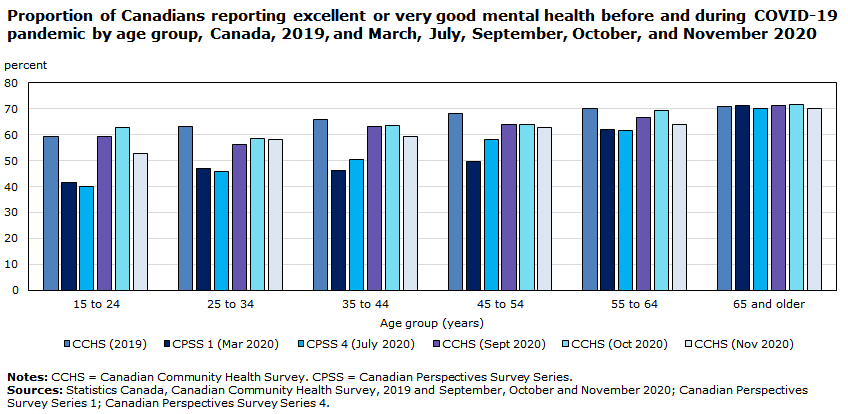
Data table
| Age group (years) | CCHS (2019) | CPSS 1 (Mar. 2020) | CPSS 4 (July 2020) | CCHS (Sept. 2020) | CCHS (Oct. 2020) | CCHS (Nov. 2020) |
|---|---|---|---|---|---|---|
| 15 to 24 | 59.3 | 41.5 | 39.9 | 59.4 | 62.7 | 52.6 |
| 25 to 34 | 63.3 | 47.1 | 45.8 | 56.2 | 58.4 | 58.2 |
| 35 to 44 | 65.8 | 46.4 | 50.4 | 63.3 | 63.4 | 59.3 |
| 45 to 54 | 68.3 | 49.8 | 58.2 | 64 | 64.1 | 62.7 |
| 55 to 64 | 70.2 | 61.9 | 61.6 | 66.6 | 69.4 | 63.8 |
| 65 and older | 70.8 | 71.2 | 70.1 | 71.4 | 71.7 | 70.2 |
|
Notes: CCHS = Canadian Community Health Survey. CPSS = Canadian Perspectives Survey Series Sources: Statistics Canada, Canadian Community Health Survey, 2019, and September, October and November, 2020; Canadian Perspectives Survey Series 1; Canadian Perspectives Survey Series 4. |
||||||
Worsening mental health among health care workers continues to be a concern
- One-third (33%) reported very good or excellent mental health and one-third (33%) reported fair or poor mental health.
- Seven in 10 health care workers who participated in a crowdsourcing initiative reported worsening mental health during the COVID-19 pandemic.
- Rates were higher among those in contact with confirmed or suspected COVID-19 cases (77%) compared with those who did not work in direct contact with people (62%).
- Access to personal protective equipment (PPE) matters—those with unrestricted access to PPE were less likely to report worsening mental health compared with those experiencing at least one restriction (63% vs. 77%).
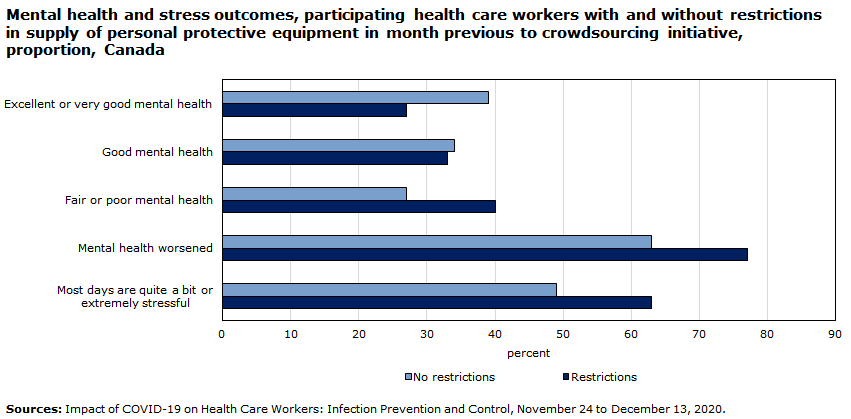
Data table
| No restrictions | Restrictions | |
|---|---|---|
| Excellent or very good mental health | 39 | 27 |
| Good mental health | 34 | 33 |
| Fair or poor mental health | 27 | 40 |
| Mental health worsened | 63 | 77 |
| Most days are quite a bit or extremely stressful |
49 | 63 |
| Sources: Impact of COVID-19 on Health Care Workers: Infection Prevention and Control, November 24 to December 13, 2020. | ||
Calls for police services increasingly linked to mental-health concerns
- Compared with last year, the number of calls for service increased by 8% during the first eight months of the pandemic, particularly wellness checks (+13%), mental health-related calls such as a person in emotional crisis (+12%), and domestic disturbances (+8%).
- Declines were reported in the number of shoplifting incidents (-47%); residential breaking and entering (-27%); motor vehicle theft (-18%); and assaults (-9%) and sexual assaults (-20%), including those by a family member.
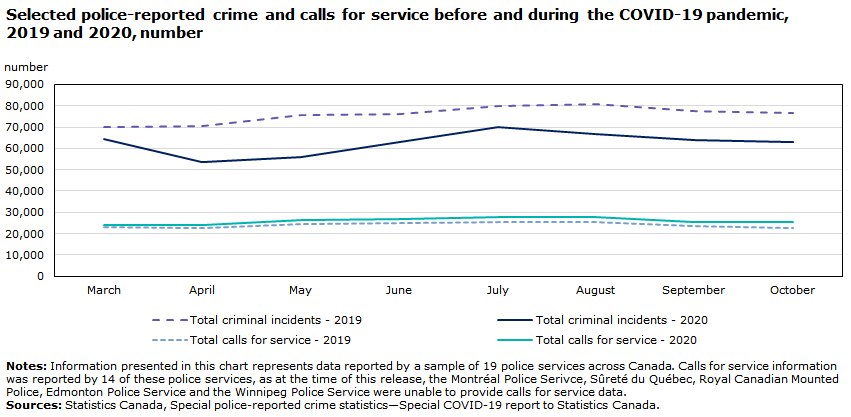
Data table
| Total criminal incidents, 2019 | Total criminal incidents, 2020 | Total calls for service, 2019 | Total calls for service, 2020 | |
|---|---|---|---|---|
| March | 70,200 | 64,447 | 22,874 | 24,214 |
| April | 70,632 | 53,587 | 22,592 | 23,857 |
| May | 75,838 | 56,103 | 24,314 | 26,236 |
| June | 76,265 | 62,862 | 24,801 | 26,754 |
| July | 79,949 | 69,952 | 25,653 | 28,008 |
| August | 80,617 | 66,977 | 25,200 | 27,742 |
| September | 77,356 | 63,973 | 23,514 | 25,342 |
| October | 76,771 | 62,894 | 22,752 | 25,622 |
|
Notes: Information presented in this chart represents data reported by a sample of 19 police services across Canada. Calls for service information was reported by 14 of these police services, as at the time of this release, the Montréal Police Serivce, Sûreté du Québec, Royal Canadian Mounted Police, Edmonton Police Service and the Winnipeg Police Service were unable to provide calls for service data. Sources: Statistics Canada, Special police-reported crime statistics—Special COVID-19 report to Statistics Canada. |
||||
Want to know more?
To learn more about the health and public safety impacts of COVID-19 early in the pandemic, see the following chapters of The Social and Economic Impacts of COVID-19: A Six-month Update:
Related articles:
Provisional death counts and excess mortality, January to November 2020
Canadians report lower self-perceived mental health during the COVID-19 pandemic
Mental health among health care workers in Canada during the COVID-19 pandemic
DID YOU KNOW?

Statistics expanded data products and insights, and producing more disaggregated data, to accurately monitor and report on the experiences of Canadians during the pandemic. The agency is making use of its robust consultation and engagement mechanism, as well as its strong relationships with stakeholders, to ensure all Canadians can see themselves in our data.
In May, Statistics Canada introduced a series of enhancements to the Labour Force Survey (LFS) that included additional questions on: working from home; job loss; capacity to meet financial obligations; and applications to federal COVID-19 assistance programs:
- The May LFS release also included the first data on current labour market conditions for youth aged 15 to 24 who were attending school full-time in March and who intend on returning to school full-time in the fall.
- As of July 2020, the LFS includes a question on visible minority status to report on how the pandemic is impacting various communities and groups in the labour market.
- Statistics Canada is also developing methods that will produce disaggregated data on race using previously-released LFS data.
Uneven social and economic impacts of COVID-19
COVID-19 mortality rates reveal the uneven health impacts of the pandemic
- Areas with the highest proportion (25% or more) of population groups designated as visible minorities had a COVID-19 mortality rate about two times higher than those with the lowest proportion (less than 1%).
- The mortality rate was more than 3 times higher in the highest-proportion areas than the lowest-proportion ones in Quebec and Ontario and more than 10 times higher in British Columbia, despite a much lower overall mortality rate.
- Quebec: 123 per 100,000 vs. 35.1 per 100,000
- Ontario: 25.9 per 100,000 vs. 7.6 per 100,000
- British Columbia: 5.6 per 100,000 vs. 0.5 per 100,000
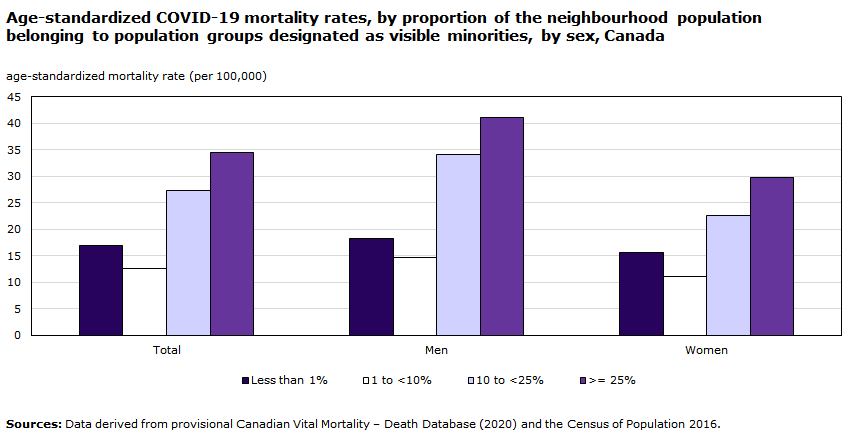
Data table
| Total | Men | Women | |
|---|---|---|---|
| age-standardized mortality rate (per 100,000) | |||
| Less than 1% | 16.9 | 18.3 | 15.6 |
| 1% to less than 10% | 12.7 | 14.7 | 11.1 |
| 10% to less than 25% | 27.3 | 34.1 | 22.7 |
| 25% or more | 34.5 | 41.0 | 29.7 |
| Sources: Data derived from provisional Canadian Vital Statistics – Death Database (2020) and 2016 Census of Population. | |||
In Montreal and Toronto, mortality rates are higher in areas with greater concentrations of Black Canadians
- Differences were largely driven by the higher rate of deaths and concentration of visible minorities in Canada’s largest cities.
- Between March and July 2020, Montréal and Toronto had the highest number of COVID‑19 deaths.
- In Montréal, the mortality rate was 149.3 per 100,000 in areas with the highest proportion of Black Canadians, compared with 88.1 per 100,000 in areas with the lowest proportion.
- In Toronto, there was a smaller difference between areas with a high vs. low proportion of South Asian Canadians (26.2 per 100,000 vs. 35 per 100,000).

Data table
| Age-standardized mortality rate (per 100,000) | |
|---|---|
| Montréal | |
| Less than 1% Black | 88.1 |
| 1% to less than 10% Black | 105.0 |
| 10% to less than 25% Black | 124.7 |
| 25% or more Black | 149.3 |
| Toronto | |
| Less than 1% South Asian | 26.2 |
| 1% to less than 10% South Asian | 24.6 |
| 10% to less than 25% South Asian | 29.5 |
| 25% or more South Asian | 35.0 |
| Sources: Data derived from provisional Canadian Vital Statistics – Death Database (2020) and 2016 Census of Population. | |
Indigenous groups are experiencing greater health impacts
- From the beginning, Indigenous people have been at greater risk of COVID-19 because of higher rates of underlying health conditions.
- By the summer, 57% of Indigenous people living with a chronic condition or disability who responded to a crowdsourcing survey said that their overall health was “much worse” or “somewhat worse” than before the pandemic.
- Similarly, 64% reported that their mental health was “much worse” or “somewhat worse.”
- Over half of participants reported a “moderate” or “major” impact on their ability to meet essential needs since the pandemic started, including food and grocery needs (54%) and PPE needs (52%), a critical factor in mitigating COVID-19 infection.
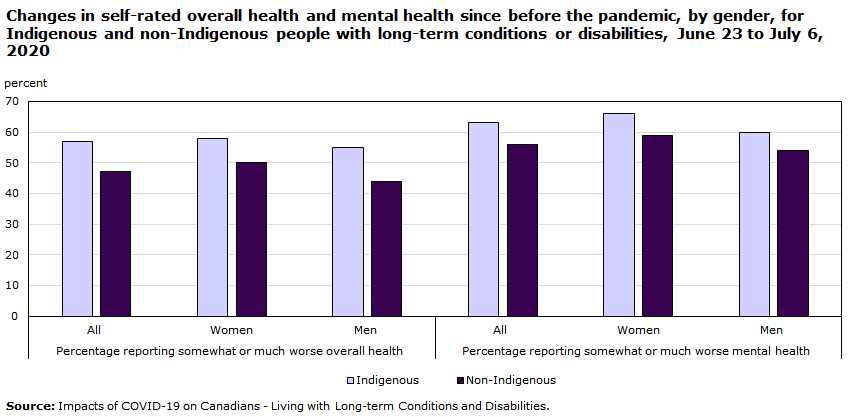
Data table
| Percentage reporting somewhat or much worse overall health | Percentage reporting somewhat or much worse mental health | |||||
|---|---|---|---|---|---|---|
| All | Women | Men | All | Women | Men | |
| percent | ||||||
| Indigenous | 57 | 58 | 55 | 63 | 66 | 60 |
| Non-Indigenous | 47 | 50 | 44 | 56 | 59 | 54 |
| Source: Impacts of COVID-19 on Canadians - Living with Long-term Conditions and Disabilities. | ||||||
Greater impacts on Indigenous people could widen pre-pandemic inequalities
- Prior to the pandemic, the unemployment rate among Indigenous people was 1.8 times the rate among non-Indigenous people, reflecting long-lasting disparities in labour market conditions.
- The initial impacts of the pandemic were similar for both Indigenous and non-Indigenous people—unemployment increased by 6.6 and 6.2 percentage points respectively in the first three months.
- By the end of 2020, unemployment remained higher among Indigenous people—12% and 11% among Indigenous men and women respectively, compared with 8% among non-Indigenous men and women.
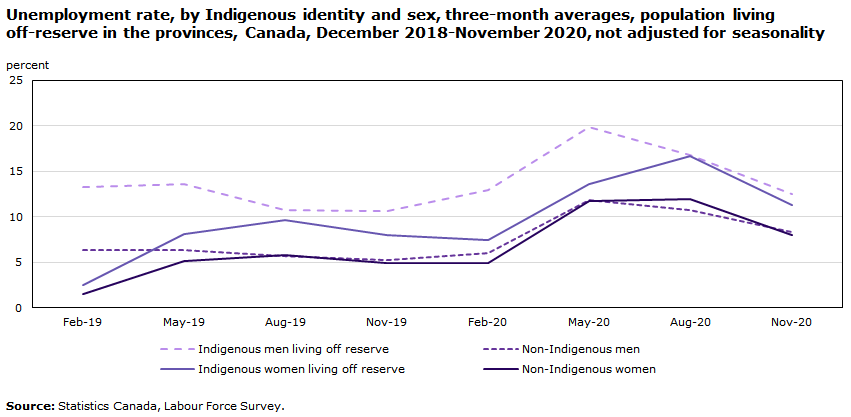
Data table
| Feb. 2019 | May 2019 | Aug. 2019 | Nov. 2019 | Feb. 2020 | May 2020 | Aug. 2020 | Nov. 2020 | |
|---|---|---|---|---|---|---|---|---|
| percent | ||||||||
| Indigenous men living off reserve | 13 | 14 | 11 | 11 | 13 | 20 | 17 | 12 |
| Non-Indigenous men | 6 | 6 | 6 | 5 | 6 | 12 | 11 | 8 |
| Indigenous women living off reserve | 3 | 8 | 10 | 8 | 7 | 14 | 17 | 11 |
| Non-Indigenous women | 2 | 5 | 6 | 5 | 5 | 12 | 12 | 8 |
| Source: Statistics Canada, Labour Force Survey. | ||||||||
Greater financial impacts on visible minority groups could threaten an inclusive recovery
Visible minority groups continue to experience:
- higher levels of unemployment
- higher levels of financial difficulties
- higher representation in low-wage jobs.
| Estimate (%) | |
|---|---|
| Total - Visible minority | 12.0 |
| South Asian | 9.6 |
| Chinese | 10.8 |
| Black | 16.4 |
| Filipino | 8.1Note E: Use with caution |
| Arab | 13.1Note E: Use with caution |
| Latin American | 16.6 |
| Southeast Asian | 20.1Note E: Use with caution |
| Not Indigenous or a visible minority | 8.9 |
|
E use with caution Source: Statistics Canada, Labour Force Survey Supplement, January 2021. |
|
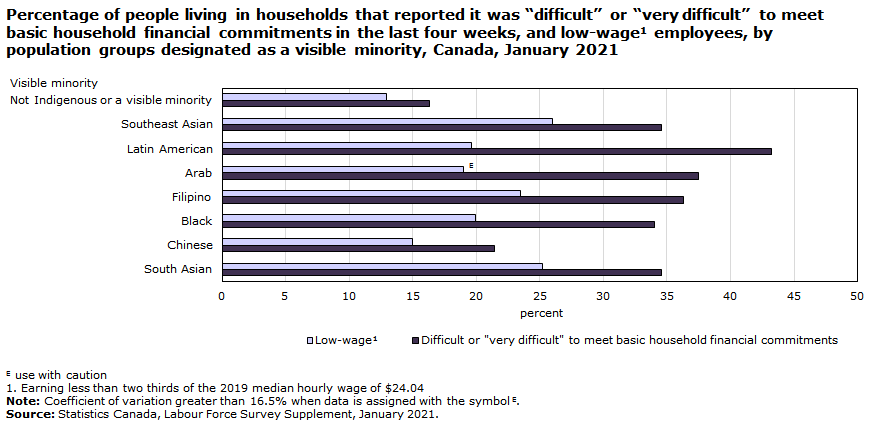
Data table
| Difficult or "very difficult" to meet basic household financial commitments | Low-wageData table 15 Note 1 employees | |
|---|---|---|
| Visible minority | ||
| South Asian | 34.6 | 25.2 |
| Chinese | 21.4 | 15.0 |
| Black | 34.0 | 19.9 |
| Filipino | 36.3 | 23.5 |
| Arab | 37.5 | 19Note E: Use with caution |
| Latin American | 43.2 | 19.6 |
| Southeast Asian | 34.6 | 26.0 |
| Not Indigenous or a visible minority | 16.3 | 12.9 |
E use with caution
Source: Statistics Canada, Labour Force Survey Supplement, January 2021. |
||
Low-wage workers continue to be among those hit hardest by lockdowns
- Low-wage workers were much more severely impacted by the COVID-19 lockdowns than by the 2008/2009 recession.

Data table
| Bottom decile | 2nd | 3rd | 4th | 5th | 6th | 7th | 8th | 9th | Top decile | |
|---|---|---|---|---|---|---|---|---|---|---|
| 2009 | 2.0 | 1.7 | 1.8 | 1.6 | 1.5 | 1.5 | 1.2 | 1.2 | 1.2 | 0.7 |
| 2020 | 6.8 | 6.3 | 4.1 | 3.7 | 2.9 | 2.2 | 2.0 | 1.8 | 1.5 | 1.0 |
|
||||||||||
- By the end of 2020, paid employment at significant hours was, for those in the bottom wage decile, 39% lower than in December 2019.
- By contrast, paid employment at significant hours was 16% higher in the top wage decile.
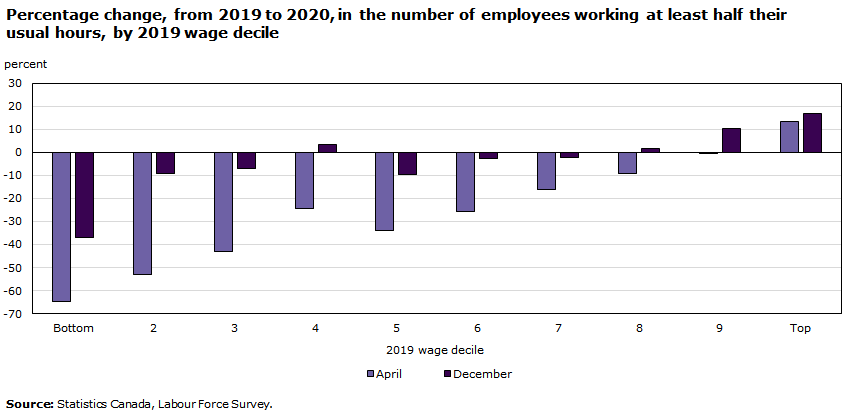
Data table
| 2019 wage decile | April | December |
|---|---|---|
| percent | ||
| Bottom | -64.9 | -36.8 |
| 2 | -53.0 | -9.0 |
| 3 | -43.2 | -6.9 |
| 4 | -24.3 | 3.5 |
| 5 | -33.9 | -9.5 |
| 6 | -25.5 | -2.6 |
| 7 | -16.1 | -2.2 |
| 8 | -9.4 | 1.8 |
| 9 | -0.3 | 10.2 |
| Top | 13.4 | 16.9 |
| Source: Statistics Canada, Labour Force Survey. | ||
Differences in the ability to work from home may contribute to higher earnings inequality
- About 4 in 10 Canadian workers are in jobs that can plausibly be done from home.
- Generally, households with lower levels of education and earnings are the least likely to hold jobs that can be done from home.
- Sustained work interruptions because of lockdowns have disproportionate impacts on financially vulnerable families and low-wage workers, potentially leading to sharp increases in earnings inequality. This is particularly likely if temporary layoffs among low-wage workers become permanent job losses.
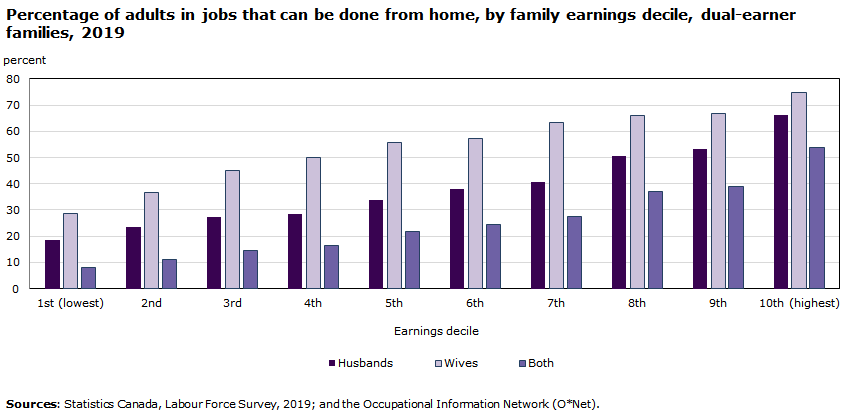
Data table
| Earnings decile | Husbands | Wives | Both |
|---|---|---|---|
| percent | |||
| All | 38.0 | 54.4 | 25.4 |
| 1st (lowest) | 18.7 | 28.6 | 8.1 |
| 2nd | 23.5 | 36.5 | 10.9 |
| 3rd | 27.3 | 45.1 | 14.7 |
| 4th | 28.3 | 49.9 | 16.3 |
| 5th | 33.8 | 55.8 | 21.7 |
| 6th | 38.0 | 57.1 | 24.6 |
| 7th | 40.5 | 63.2 | 27.6 |
| 8th | 50.7 | 65.9 | 36.9 |
| 9th | 53.1 | 66.9 | 39.1 |
| 10th (highest) | 66.1 | 74.8 | 53.9 |
| Sources: Statistics Canada, Labour Force Survey, 2019; and the Occupational Information Network (O*Net). | |||
Returns to employment are greater among professions with greater teleworking capacity
- In January 2021, the number of Canadians working from home rose by nearly 700,000 to 5.4 million, surpassing the 5.1 million who worked from home during the initial lockdowns in April 2020.
- Increases in educational services accounted for part of the increase in telework, as many schools transitioned to remote learning.
- Telework capacity is over 80% in professional, scientific and technical services. Employment in this industry returned to pre-COVID-19 levels by September and, as of January 2021, was 4.9% above levels observed in February 2020.
- Telework capacity in accommodation and food services is about 5%. As of January 2021, employment was still down one-third from pre-pandemic levels, and the sector accounted for 45% of net employment losses since COVID-19 began.

Data table
| Industry | Telework capacity |
|---|---|
| percent | |
| Agriculture, forestry, fishing, hunting | 3.9 |
| Accommodation, food services | 5.6 |
| Construction | 11.1 |
| Manufacturing | 19.1 |
| Retail trade | 22.0 |
| Mining, quarrying, oil and gas extraction | 23.9 |
| Transportation, warehousing | 24.5 |
| Health care, social assistance | 28.8 |
| Other services (except public administration) | 31.4 |
| Administrative and support, waste management, remediation | 35.1 |
| Utilities | 38.6 |
| Arts, entertainment, recreation | 40.1 |
| Real estate, rental and leasing | 47.8 |
| Wholesale trade | 57.3 |
| Public administration | 58.2 |
| Information, cultural industries | 68.5 |
| Professional, scientific and technical services | 83.9 |
| Educational services | 84.6 |
| Finance, insurance | 85.3 |
| Source: Statistics Canada, Labour Force Survey, 2019; and the Occupational Information Network (O*NET). | |
Young Canadians remain the most impacted by lockdowns
- After seven months of gains, employment fell in December and January as public health restrictions tightened in many regions of the country. Total employment declined by 266,000 during this two-month period—over one-half of these employment losses (148,000) were among young Canadians.

Data table
| Percent | |
|---|---|
| 2020 | |
| January | 10.4 |
| February | 10.4 |
| March | 17.0 |
| April | 27.3 |
| May | 29.1 |
| June | 27.4 |
| July | 23.9 |
| August | 22.7 |
| September | 18.7 |
| October | 18.5 |
| November | 17.2 |
| December | 17.8 |
| 2021 | |
| January | 19.7 |
| Source: Statistics Canada table 14-10-0287-01. | |
- As of January, 15- to 24-year-olds accounted for 45% of net employment losses since the onset of the pandemic (377,000 out of 858,000).

Data table
| February | March | April | May | June | July | August | September | October | November | December | January | |
|---|---|---|---|---|---|---|---|---|---|---|---|---|
| All youth | 100.0 | 93.1 | 76.2 | 77.6 | 82.9 | 78.3 | 80.7 | 88.8 | 86.7 | 89.9 | 91.8 | 92.2 |
| Males | 100.0 | 94.1 | 77.3 | 78.6 | 83.5 | 80.4 | 82.3 | 88.8 | 87.6 | 91.8 | 91.4 | 95.7 |
| Females | 100.0 | 91.8 | 74.7 | 76.3 | 82.0 | 75.2 | 78.4 | 88.7 | 85.3 | 87.1 | 92.3 | 87.4 |
| Source: Statistics Canada, Table 14-10-0287-01. | ||||||||||||
Following historic highs in April, there was a decrease in the number of young people not in employment, education or training (NEET)
- Among postsecondary students who responded to Statistics Canada’s crowdsourcing exercise, 26% indicated that their education had been disrupted by the lockdowns.
- Youth not attending school, plus a decrease in employment, contributed to historic highs in NEET rates, rising to 24% in April, the highest in 20 years.
- NEET rates among 20- to 24-year-olds measured in September, October and November were up to 3.5 percentage points higher than in January 2020. However, by December, these rates were comparable to pre-pandemic levels.
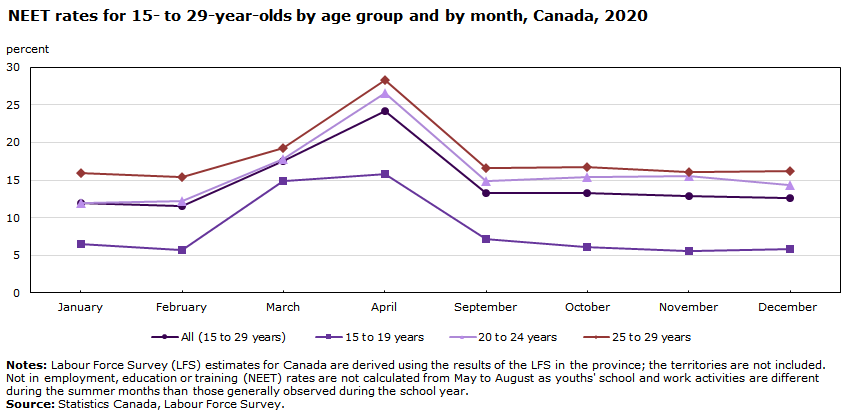
Data table
| Age group | January | February | March | April | September | October | November | December |
|---|---|---|---|---|---|---|---|---|
| percent | ||||||||
| All (15 to 29 years) | 12 | 12 | 18 | 24 | 13 | 13 | 13 | 13 |
| 15 to 19 years | 6 | 6 | 15 | 16 | 7 | 6 | 6 | 6 |
| 20 to 24 years | 12 | 12 | 18 | 27 | 15 | 15 | 15 | 14 |
| 25 to 29 years | 16 | 15 | 19 | 28 | 17 | 17 | 16 | 16 |
|
Notes: Labour Force Survey (LFS) estimates for Canada are derived using the results of the LFS in the province; the territories are not included. Not in employment, education or training (NEET) rates are not calculated from May to August as youths' school and work activities are different during the summer months than those generally observed during the school year. Source: Statistics Canada, Labour Force Survey. |
||||||||
New registrations and certifications in skilled trades decreased in 2020
- In 2019, new registrations in apprenticeship programs (-2.9%) and certifications in the trades (-3.9%) fell from 2018, continuing the multi-year downward trend first set in motion by the collapse of oil prices in 2014.
- Preliminary results suggest that new registrations (-43.0%) and certifications (-48.7%) in the trades decreased by almost half in the first nine months of 2020 compared with the same period in 2019.
- Sustained declines in new registrations in apprenticeship programs and certifications in the trades may lead to increased pressure on an already aging skilled labour force.

Data table
| New registrations (2019) | New preliminary registrations (2020) | Certificates granted (2019) | Preliminary certifications (2020) | |
|---|---|---|---|---|
| number | ||||
| February | 4,383 | 3,905 | 2,271 | 2,472 |
| March | 4,722 | 3,540 | 3,327 | 2,693 |
| April | 4,593 | 1,323 | 3,408 | 1,340 |
| May | 4,677 | 1,467 | 3,444 | 863 |
| June | 4,710 | 2,099 | 3,642 | 860 |
| July | 4,461 | 2,517 | 2,898 | 946 |
| August | 4,305 | 2,541 | 2,202 | 1,227 |
| September | 4,719 | 3,438 | 2,103 | 1,542 |
|
Note: Preliminary aggregate estimates for 2020 were provided by 11 participating provinces and territories. Quebec and Nunavut were not included in this analysis. Final results will vary as disaggregated data for 2020 are collected from all provinces and territories and are edited for consistency and validated in collaboration with provincial and territorial representatives. Source: Statistics Canada, Registered Apprenticeship Information System, 2019, and preliminary 2020 estimates. |
||||
Postsecondary students are facing higher fees despite studying online
- Nationally, students enrolled full time in undergraduate programs will pay $6,580 on average in 2020/2021, up 1.7% from the previous year. The average cost for graduate programs rose by 1.6% to $7,304.
- Faced with fewer job prospects, over three-quarters of returning students (77%) who responded to Statistics Canada’s crowdsourcing survey were very or extremely concerned about their finances.
- While the Canada Emergency Student Benefit reduced these concerns, almost one-half of returning students who participated in the survey were still worried about their ability to pay tuition.
- Average tuition fees for international undergraduate and graduate students in Canada rose 7.1% to $32,019 and 7.3% to $19,252, respectively, in 2020/2021.
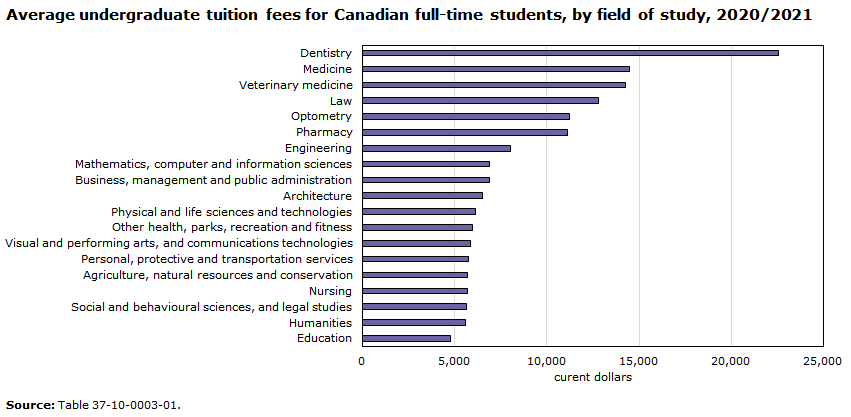
Data table
| Current dollars | |
|---|---|
| Education | 4,761 |
| Humanities | 5,602 |
| Social and behavioural sciences, and legal studies | 5,632 |
| Nursing | 5,688 |
| Agriculture, natural resources and conservation | 5,718 |
| Personal, protective and transportation services | 5,726 |
| Visual and performing arts, and communications technologies | 5,865 |
| Other health, parks, recreation and fitness | 5,943 |
| Physical and life sciences and technologies | 6,156 |
| Architecture | 6,517 |
| Business, management and public administration | 6,887 |
| Mathematics, computer and information sciences | 6,895 |
| Engineering | 8,047 |
| Pharmacy | 11,133 |
| Optometry | 11,235 |
| Law | 12,813 |
| Veterinary medicine | 14,270 |
| Medicine | 14,483 |
| Dentistry | 22,562 |
| Source: Table 37-10-0003-01. | |
Want to know more?
To learn more about the early impacts of COVID-19 on selected population groups, see the following chapters of The Social and Economic Impacts of COVID-19: A Six-month Update:
- Impacts on Immigrants and People Designated as Visible Minorities
- Impacts on Indigenous Peoples
- Impacts on Parents and Children
- Impacts on Youth.
Related articles:
COVID-19 mortality rates in Canada’s ethno-cultural neighbourhoods
Indigenous people and mental health during the COVID-19 pandemic
Labour market impacts of COVID-19 on Indigenous people: March to August 2020
Inequality in the feasibility of working from home during and after COVID-19
LEVERAGING KEY PARTNERSHIPS

Working with partners, Statistics Canada has adjusted its operations to deliver timely information to Canadians:
- In collaboration with the Canadian Chamber of Commerce, and in less than 2 weeks, we delivered a new survey to take the pulse of businesses during COVID. This helps them and governments to make quick and informed decisions to support their operations and their employees
- Adding Labour Force Survey (LFS) enhancements in May 2020, including questions on working from home, job loss, capacity to meet financial obligations, and applications to federal COVID-19 assistance programs.
- Supported provinces, territories and some municipalities with our interviewing expertise to help contact tracing efforts -- as of early March 2021, our interviewers have completed over 300,000 calls.
- Working with Indigenous leaders and organizations to bolster data management capacity and expertise.
- Partnering with City of Vancouver and Federation of Canadian Municipalities to further understanding of social and economic impact of pandemic, with the aim to further support other municipalities.
- Co-hosting hackathons with Children First Canada and other partners to address challenges and identify new and effective ways to use real-time data to empower decision-makers.
Economic impacts: Assessing the recovery
Economic activity remains below pre-pandemic levels
The historic declines in output, employment and hours worked that resulted from the economic shutdown in the spring of 2020 affected virtually all sectors of the economy.
As public health measures eased during the summer and early fall, overall economic activity remained below pre-pandemic levels.
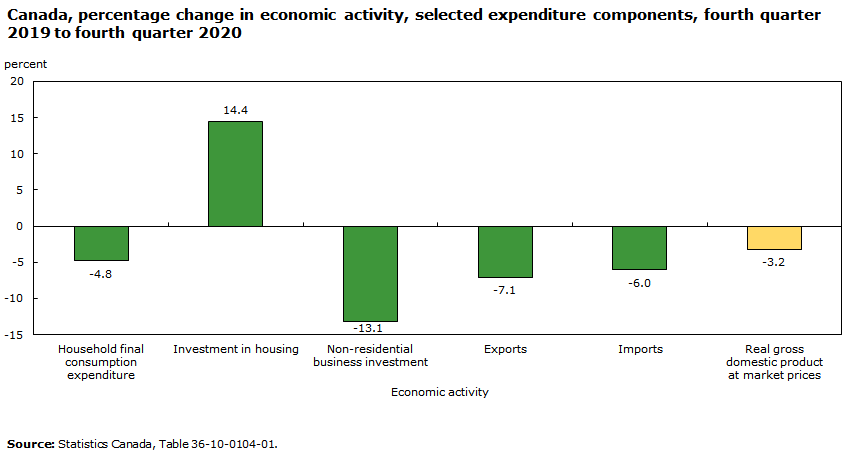
Data table
| Economic activity | Q4 2019 to Q4 2020 |
|---|---|
| percent | |
| Household final consumption expenditure | -4.8 |
| Investment in housing | 14.4 |
| Non-residential business investment | -13.1 |
| Exports | -7.1 |
| Imports | -6.0 |
| Real gross domestic product at market prices | -3.2 |
| Source: Statistics Canada, Table 36-10-0104-01. | |
The pace of recovery slowed as tighter restrictions took effect in late 2020.
Economy-wide output in December remained 3.3% below pre-COVID levels.
At year end, 1.1 million workers were impacted by COVID-19 through employment losses or substantial reductions in hours worked.
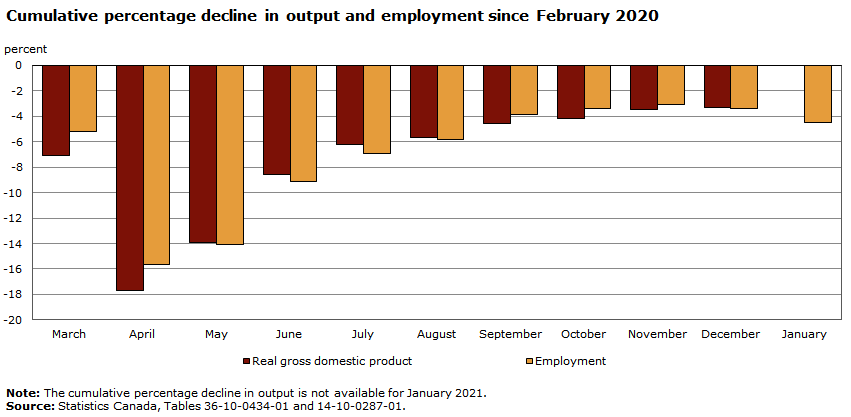
Data table
| Real gross domestic product | Employment | |
|---|---|---|
| percent | ||
| 2020 | ||
| March | -7 | -5 |
| April | -18 | -16 |
| May | -14 | -14 |
| June | -9 | -9 |
| July | -6 | -7 |
| August | -6 | -6 |
| September | -5 | -4 |
| October | -4 | -3 |
| November | -3 | -3 |
| December | -3 | -3 |
| 2021 | ||
| January | Note ..: not available for a specific reference period | -4 |
|
.. not available for a specific reference period Note: The cumulative percentage decline in output is not available for January 2021. Source: Statistics Canada, tables 3610043401 and 1410028701. |
||
The number of active businesses has declined in most industrial sectors
While businesses that provide accommodation and food services remained severely impacted, the number of active businesses has declined substantially in most sectors, largely reflecting closures among small firms.
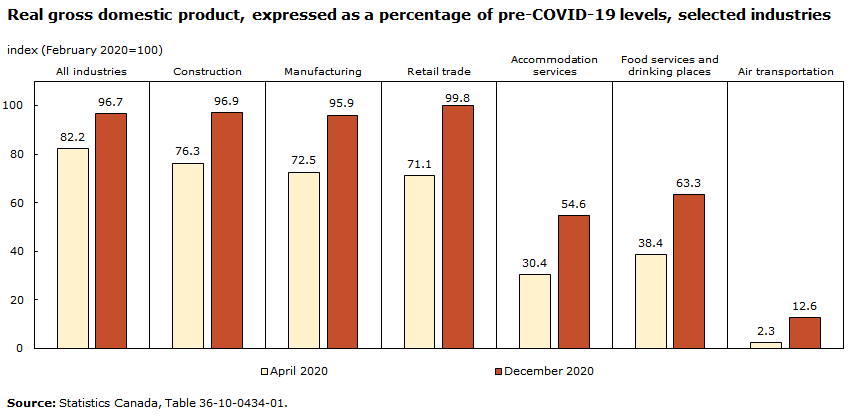
Data table
| April 2020 | December 2020 | |
|---|---|---|
| index (February 2020=100) | ||
| All industries | 82.2 | 96.7 |
| Construction | 76.3 | 96.9 |
| Manufacturing | 72.5 | 95.9 |
| Retail trade | 71.1 | 99.8 |
| Accommodation services | 30.4 | 54.6 |
| Food services and drinking places | 38.4 | 63.3 |
| Air transportation | 2.3 | 12.6 |
| Source: Statistics Canada, Table 36-10-0434-01. | ||
As of November, the number of active firms remained 4.5% below pre-pandemic levels.
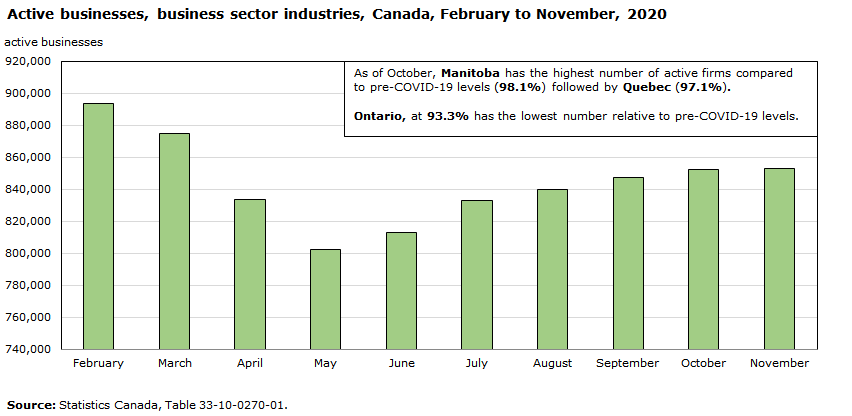
Data table
| Active businesses | |
|---|---|
| number | |
| February | 893,473 |
| March | 874,669 |
| April | 833,585 |
| May | 801,962 |
| June | 812,715 |
| July | 832,956 |
| August | 839,876 |
| September | 847,388 |
| October | 852,387 |
| November | 852,996 |
|
Note: The text box in the chart reads as follows: As of October, Manitoba had the highest number of active firms compared with pre-COVID-19 levels (98.1%), followed by Quebec (97.1%). Ontario, at 93.3%, had the lowest number relative to pre-COVID-19 levels. Source: Statistics Canada, Table 33-10-0270-01. |
|
The economic impacts of the pandemic were not felt equally across the country
- As of September 2020, Alberta, Saskatchewan and Ontario showed the largest declines in economic activity.
- Lower activity in Alberta reflected declines in energy prices.
- Lower activity in Ontario reflected tighter restrictions on economic activity.
- Manitoba, Yukon and Nunavut were among the least-affected economies.
- The effects of COVID-19 in New Brunswick, Nova Scotia, British Columbia and Quebec were less severe or these provinces began relaxing restrictions earlier.
- Estimates of estimates of economic activity in October, showed that the pace of the recovery had slowed in most provinces and territories. Lower economic activity in Quebec in October reflected the earlier reintroduction of stronger public health restrictions.

Data table
| Method 1: PCA-based index | Method 2: LASSO-based index | |
|---|---|---|
| percent | ||
| Alberta | -31.6 | -13.8 |
| Saskatchewan | -19.6 | -0.5 |
| Northwest Territories | -11.7 | Note .: not available for any reference period |
| Ontario | -10.6 | -1.6 |
| New Brunswick | -9.4 | 0.5 |
| Nova Scotia | -7.7 | 0.7 |
| Prince Edward Island | -5.6 | 1.8 |
| British Columbia | -4.8 | -0.3 |
| Quebec | -3.5 | 1.5 |
| Manitoba | 2.2 | 2.9 |
| Yukon | 3.6 | 2.4 |
| Newfoundland and Labrador | Note .: not available for any reference period | -1.0 |
| Nunavut | Note .: not available for any reference period | 5.4 |
|
. not available for any reference period Note: PCA: principal component analysis; LASSO: least absolute shrinkage and selection operator. Source: Statistics Canada, Table 36-10-0633-01. |
||
Emergency response programs are mitigating the impact of the pandemic on businesses
Businesses across all industries are being supported by at least one emergency response program.
On average, businesses were receiving $83,000 in support.
Program usage, at over 50%, was highest in accommodation and food services.
After receiving the Canada Emergency Wage Subsidy, businesses in accommodation and food services were also the most likely to rehire workers.
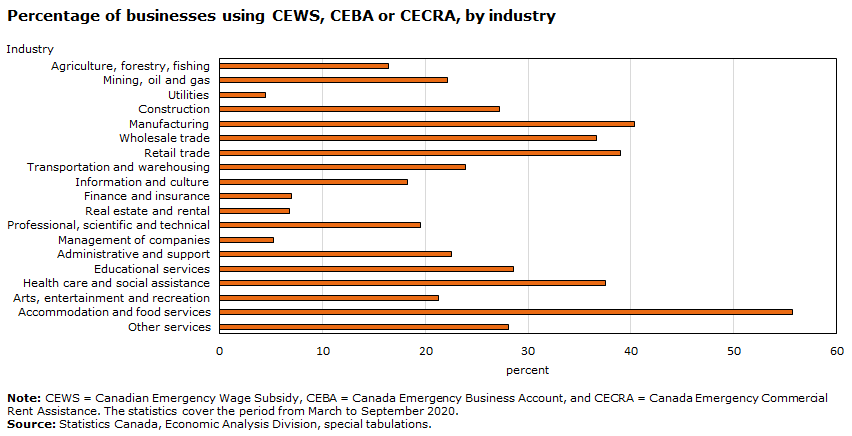
Data table
| Industry | Canada Emergency Wage Subsidy |
|---|---|
| percent | |
| Other services | 28 |
| Accommodation and food services | 56 |
| Arts, entertainment and recreation | 21 |
| Health care and social assistance | 38 |
| Educational services | 29 |
| Administrative and support | 23 |
| Management of companies | 5 |
| Professional, scientific and technical | 20 |
| Real estate and rental | 7 |
| Finance and insurance | 7 |
| Information and culture | 18 |
| Transportation and warehousing | 24 |
| Retail trade | 39 |
| Wholesale trade | 37 |
| Manufacturing | 40 |
| Construction | 27 |
| Utilities | 4 |
| Mining, oil and gas | 22 |
| Agriculture, forestry and fishing | 16 |
|
Note: CEWS = Canadian Emergency Wage Subsidy, CEBA = Canada Emergency Business Account, and CECRA = Canada Emergency Commercial Rent Assistance. The statistics cover the period from March to September 2020. Source: Statistics Canada, Economic Analysis Division, special tabulations. |
|
With fall 2020's tighter restrictions on businesses, high levels of uncertainty exist
- During the fall, almost 20% of businesses reported that they would be able to operate for less than six months at current revenue and expenditure levels, and 30% more were uncertain as to how long they could continue to operate.

Data table
| Length of time | Operation at current revenue and expenditure levels |
|---|---|
| percent | |
| Less than 3 months | 6.2 |
| Less than 6 months | 17.5 |
| Unknown | 30.4 |
| Source: Statistics Canada, Table 33-10-0293-01. | |
- Overall, over 40% of businesses reported that they could not take on additional debt.
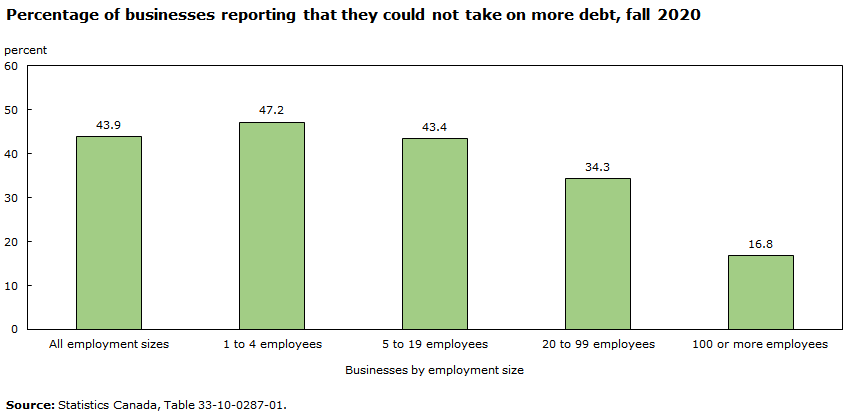
Data table
| Businesses by employment size | Cannot take on more debt |
|---|---|
| percent | |
| All employment sizes | 43.9 |
| 1 to 4 employees | 47.2 |
| 5 to 19 employees | 43.4 |
| 20 to 99 employees | 34.3 |
| 100 or more employees | 16.8 |
| Source: Statistics Canada, Table 33-10-0287-01. | |
Emergency support programs continued to bolster household incomes and savings
- New estimates of household economic well-being provided more insight into the extent to which emergency support measures benefited different groups of households.
- The emergency support measures more than compensated for lost wages and salaries during the initial lockdowns, irrespective of household income levels.
- Households in the bottom income quintile saw their disposable income rise by 33% in the second quarter, while incomes in the top quintile grew by 7%.
- Over the first three quarters of 2020, the value of government COVID-19 support measures represented 16.4% of disposable income for the lowest-income earners, compared with 4.3% among the highest earners.
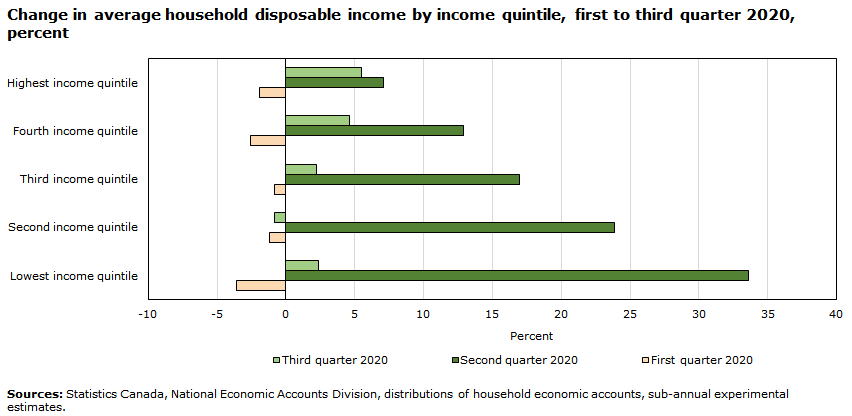
Data table
| First quarter 2020 | Second quarter 2020 | Third quarter 2020 | |
|---|---|---|---|
| percent | |||
| Lowest income quintile | -3.6 | 33.6 | 2.4 |
| Second income quintile | -1.2 | 23.9 | -0.8 |
| Third income quintile | -0.8 | 17.0 | 2.2 |
| Fourth income quintile | -2.6 | 12.9 | 4.6 |
| Highest income quintile | -1.9 | 7.1 | 5.5 |
| Sources: Statistics Canada, National Economic Accounts Division, distributions of household economic accounts, sub-annual experimental estimates. | |||
As employment recovers, losses continue to be uneven and unequal
- After seven months of gains, employment fell by over 250,000 from November to January, reflecting losses in service industries most impacted by tighter restrictions.
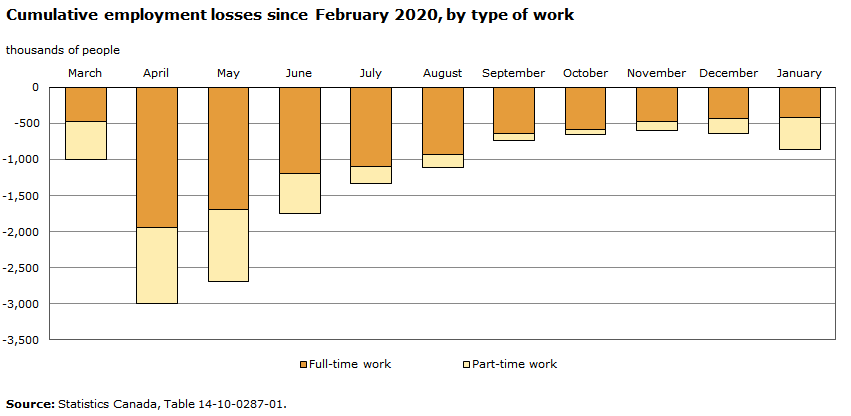
Data table
| Full-time work | Part-time work | |
|---|---|---|
| thousands of people | ||
| 2020 | ||
| March | -469 | -527 |
| April | -1,949 | -1,040 |
| May | -1,694 | -992 |
| June | -1,196 | -549 |
| July | -1,101 | -226 |
| August | -929 | -185 |
| September | -646 | -96 |
| October | -588 | -59 |
| November | -479 | -114 |
| December | -436 | -210 |
| 2021 | ||
| January | -423 | -435 |
| Source: Statistics Canada, Table 14-10-0287-01. | ||
- As of January 2021, young Canadians accounted for 44% of net employment losses since the onset of the pandemic.

Data table
| Age group and sex | Indexed employment level during COVID-19 economic shutdown (April 2020) | Indexed employment level during current reference month (January 2021) |
|---|---|---|
| index (February 2020=100) | ||
| Youth, male | 69 | 88 |
| Youth, female | 62 | 83 |
| Core age, male | 88 | 97 |
| Core age, female | 87 | 97 |
| Older, male | 88 | 98 |
| Older, female | 86 | 96 |
|
Notes: Youth: 15- to 24-year-olds; core age: 25- to 54-year-olds; older: 55-year-olds and older. Source: Statistics Canada, Table 14-10-0287-01. |
||
Workers in lower-paying service industries remain severely affected
- As of December 2020, employment at significant hours was 4.7% lower overall than it was in December 2019.
- In accommodation and food services, the employment gap over this one-year period was 30%.
- The corresponding gap was 39% in arts, entertainment and recreation.
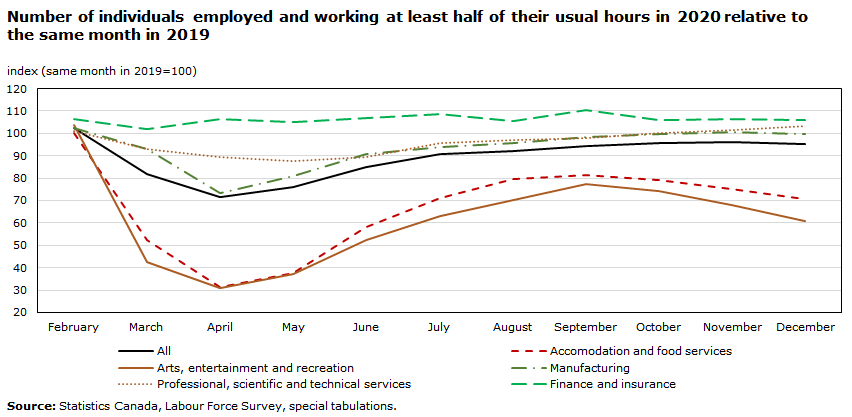
Data table
| All | Accommodation and food services | Arts, entertainment and recreation | Manufacturing | Professional, scientific and technical services | Finance and insurance | |
|---|---|---|---|---|---|---|
| index (same month in 2019=100) | ||||||
| February | 102.5 | 100.0 | 103.9 | 102.4 | 101.1 | 106.6 |
| March | 81.7 | 52.6 | 42.6 | 93.0 | 93.2 | 101.8 |
| April | 71.5 | 31.5 | 30.9 | 73.1 | 89.3 | 106.6 |
| May | 75.9 | 37.5 | 37.2 | 80.9 | 87.6 | 105.3 |
| June | 84.8 | 58.2 | 52.4 | 91.0 | 89.4 | 106.9 |
| July | 90.7 | 71.1 | 63.3 | 94.0 | 95.5 | 108.7 |
| August | 92.3 | 79.8 | 70.0 | 95.8 | 97.2 | 105.5 |
| September | 94.2 | 81.3 | 77.4 | 98.6 | 98.1 | 110.4 |
| October | 95.9 | 79.2 | 74.2 | 99.5 | 100.2 | 105.8 |
| November | 96.0 | 75.3 | 68.1 | 100.6 | 101.3 | 106.5 |
| December | 95.3 | 70.5 | 60.9 | 99.8 | 103.3 | 105.8 |
| Source: Statistics Canada, Labour Force Survey, special tabulations. | ||||||
The initial lockdowns led to a sharp rise in long-term unemployment
- The number of long-term unemployed workers rose sharply in September and October as a result of the initial lockdowns.
- As of January 2021, 512,000 workers were experiencing long-term unemployment, about 27% of all unemployed people. This proportion stood below 16% prior to COVID-19.
- The degree to which COVID-19 results in permanent layoffs is crucial to understanding how the pandemic will affect Canadian workers over the longer term. During recent decades, at least one in five permanently laid-off workers saw their real earnings decline by at least 25%, even five years after job loss.
- During the last three recessions, 45% of workers were permanently laid off.

Data table
| Months since beginning of downturn | 1981/1982 recession | 1990-to-1992 recession | 2008/2009 recession | COVID-19 economic downturn |
|---|---|---|---|---|
| index of unemployed peopleData table 37 Note 1 | ||||
| 1 | 100.0 | 100.0 | 100.0 | 100.0 |
| 2 | 103.3 | 105.5 | 109.6 | 84.0 |
| 3 | 109.9 | 107.7 | 107.8 | 73.4 |
| 4 | 123.2 | 115.7 | 119.9 | 84.2 |
| 5 | 121.4 | 118.5 | 123.6 | 99.6 |
| 6 | 117.2 | 124.5 | 135.5 | 123.6 |
| 7 | 128.8 | 143.2 | 138.8 | 129.0 |
| 8 | 129.8 | 143.6 | 154.0 | 173.9 |
| 9 | 128.5 | 144.7 | 170.8 | 252.8 |
| 10 | 137.7 | 152.5 | 186.3 | 253.3 |
| 11 | 152.2 | 168.9 | 185.8 | 280.4 |
| 12 | 159.8 | 170.2 | 194.1 | 285.4 |
| 13 | 182.4 | 184.9 | 206.6 | Note ...: not applicable |
| 14 | 219.4 | 191.6 | 219.0 | Note ...: not applicable |
| 15 | 236.8 | 198.8 | 205.2 | Note ...: not applicable |
| 16 | 260.9 | 196.0 | 213.9 | Note ...: not applicable |
| 17 | 277.9 | 193.5 | 220.7 | Note ...: not applicable |
| 18 | 292.5 | 195.3 | 230.7 | Note ...: not applicable |
| 19 | 311.8 | 200.3 | 222.4 | Note ...: not applicable |
| 20 | 322.3 | 200.1 | 220.4 | Note ...: not applicable |
| 21 | 330.1 | 210.7 | 205.5 | Note ...: not applicable |
| 22 | 346.7 | 220.7 | 212.9 | Note ...: not applicable |
| 23 | 341.6 | 224.5 | 218.2 | Note ...: not applicable |
| 24 | 343.6 | 223.1 | 225.8 | Note ...: not applicable |
| 25 | 346.8 | 232.2 | 208.2 | Note ...: not applicable |
| 26 | 321.2 | 231.6 | 209.2 | Note ...: not applicable |
| 27 | 316.4 | 244.9 | 221.9 | Note ...: not applicable |
| 28 | 296.0 | 245.1 | 215.0 | Note ...: not applicable |
| 29 | 293.5 | 250.7 | 216.0 | Note ...: not applicable |
| 30 | 294.9 | 262.5 | 204.9 | Note ...: not applicable |
| 31 | 281.7 | 254.0 | 208.6 | Note ...: not applicable |
| 32 | 285.0 | 255.6 | 194.0 | Note ...: not applicable |
| 33 | 293.5 | 258.9 | 221.4 | Note ...: not applicable |
| 34 | 281.4 | 265.2 | 208.4 | Note ...: not applicable |
| 35 | 286.9 | 255.7 | 202.7 | Note ...: not applicable |
| 36 | 301.4 | 265.8 | 200.5 | Note ...: not applicable |
| 37 | 294.2 | 264.7 | 202.1 | Note ...: not applicable |
| 38 | 292.7 | 270.9 | 200.5 | Note ...: not applicable |
| 39 | 280.2 | 261.1 | 212.9 | Note ...: not applicable |
| 40 | 284.5 | 259.5 | 201.6 | Note ...: not applicable |
| 41 | 287.7 | 264.0 | 197.9 | Note ...: not applicable |
| 42 | 288.8 | 264.7 | 177.7 | Note ...: not applicable |
| 43 | 285.2 | 258.0 | 176.4 | Note ...: not applicable |
| 44 | 273.0 | 255.3 | 185.2 | Note ...: not applicable |
| 45 | 283.0 | 257.5 | 162.1 | Note ...: not applicable |
| 46 | 294.2 | 236.0 | 179.7 | Note ...: not applicable |
| 47 | 283.8 | 252.5 | 187.6 | Note ...: not applicable |
| 48 | 275.5 | 248.9 | 179.2 | Note ...: not applicable |
| 49 | 274.7 | 234.4 | 187.0 | Note ...: not applicable |
| 50 | 258.1 | 219.8 | 186.9 | Note ...: not applicable |
... not applicable
Sources: Statistics Canada, Table 14-10-0342-01. |
||||
As restrictions ease, a rebound in immigration will be critical to labour-market recovery
- Immigration accounts for much of the overall growth in Canada’s labour force. Since the start of the pandemic, the number of new immigrants admitted to Canada has been down about 60%.
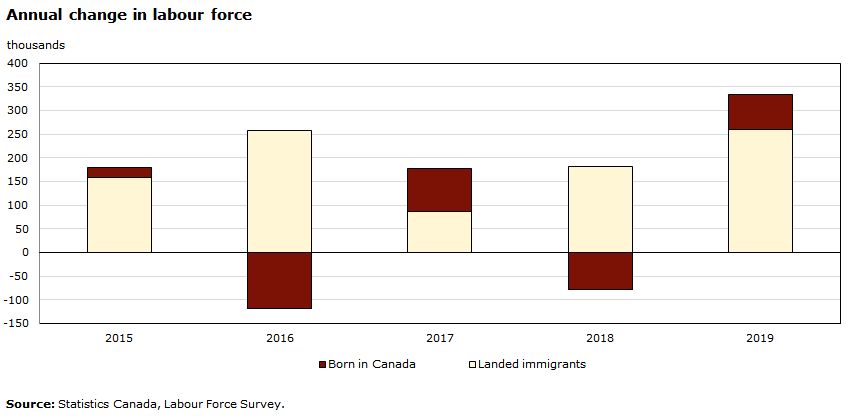
Data table
| 2015 | 2016 | 2017 | 2018 | 2019 | |
|---|---|---|---|---|---|
| thousands | |||||
| Landed immigrants | 157.3 | 258.1 | 87.0 | 182.0 | 260.0 |
| Born in Canada | 21.9 | -118.5 | 90.3 | -77.3 | 73.4 |
| Source: Statistics Canada, Labour Force Survey. | |||||
- As immigration returns to planned levels, matching the skills of immigrants with regional labour demand will be a key component of supporting economic recovery.
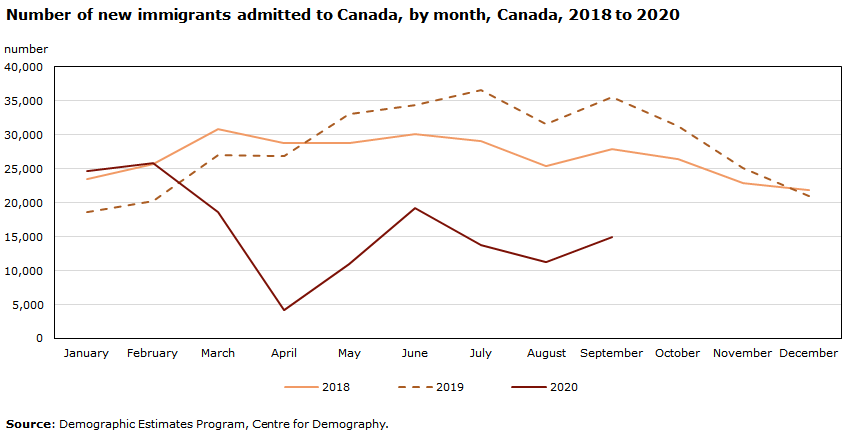
Data table
| Month | 2018 | 2019 | 2020 |
|---|---|---|---|
| number | |||
| January | 23,549 | 18,647 | 24,696 |
| February | 25,645 | 20,250 | 25,899 |
| March | 30,813 | 27,060 | 18,567 |
| April | 28,825 | 26,899 | 4,135 |
| May | 28,784 | 33,017 | 10,954 |
| June | 30,070 | 34,365 | 19,182 |
| July | 29,044 | 36,617 | 13,731 |
| August | 25,316 | 31,587 | 11,332 |
| September | 27,923 | 35,515 | 15,006 |
| October | 26,396 | 31,238 | Note ..: not available for a specific reference period |
| November | 22,877 | 25,080 | Note ..: not available for a specific reference period |
| December | 21,807 | 20,917 | Note ..: not available for a specific reference period |
|
.. not available for a specific reference period Source: Demographic Estimates Program, Centre for Demography. |
|||
COVID-19 led to sharp fluctuations in business productivity
Labour productivity rose sharply during the initial lockdowns as a decline in hours worked outpaced the fall in business output. Productivity then fell sharply in the third quarter as both output and hours worked rebounded.
- As restrictions eased, large increases in hours worked among small companies and the self-employed contributed to lower productivity, as these businesses are less productive than larger firms.
- The pandemic may result in a significant amount of labour and capital being shifted between sectors, which will impact the growth and productivity of the economy as a whole.
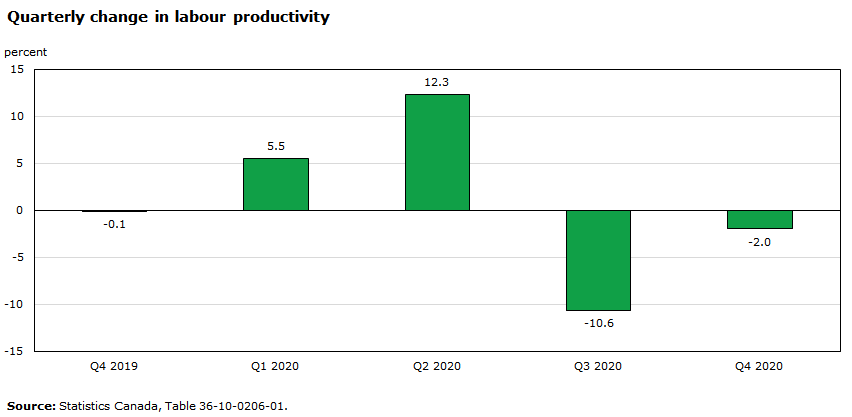
Data table
| Q4 2019 | Q1 2020 | Q2 2020 | Q3 2020 | Q4 2020 | |
|---|---|---|---|---|---|
| percent | |||||
| Labour productivity | -0.1 | 5.5 | 12.3 | -10.6 | -2.0 |
| Source: Statistics Canada, Table 36-10-0206-01. | |||||
Business productivity has increased as economic resources have been transferred across sectors
- Overall, labour productivity growth was much higher over the first three quarters of 2020 compared with average productivity growth over the last decade.
- This reflects both productivity gains within industries and large structural contributions to productivity growth as labour and capital are transferred across industries.
- Productivity gains within industries in 2020 may reflect changes in business practices because of COVID-19, along with the increased adoption of digital technologies, which accelerated rapidly during the pandemic.
- The structural contributions to overall productivity growth reflect resources being transferred out of service industries with below-average productivity.

Data table
| 2020 (first three quarters) | 2010 to 2019 | |
|---|---|---|
| percent | ||
| Structural changes | 1.90 | 0.19 |
| Industry productivity growth | 3.40 | 0.95 |
| Aggregate labour productivity | 5.30 | 1.14 |
| Source: Statistics Canada, Economic Analysis Division, special tabulations. | ||
Some sectors experienced substantial productivity gains in 2020
- Productivity rose in industries that are digital and information and communications technology-intensive, such as wholesale trade; retail trade; finance, insurance and real estate; and other services (including health and education).
- For industries such as accommodation and food services, and arts, entertainment and recreation, rising productivity may largely reflect declines in hours worked among lower-paid workers who were hit harder by economic shutdowns.
- As these lower-paid services have below-average productivity levels, a decline in their share of hours worked raises productivity for the economy as a whole.
- A key issue: Which of these changes will be permanent and which will be transitory?
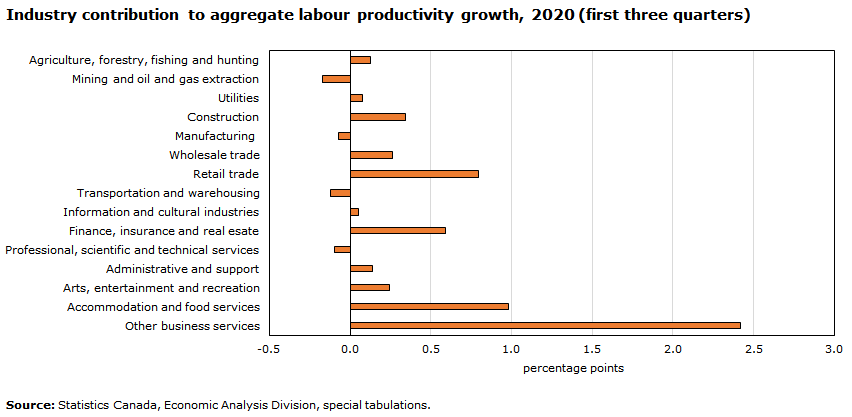
Data table
| Industry | 2020 |
|---|---|
| percentage points | |
| Agriculture, forestry, fishing and hunting | 0.13 |
| Mining and oil and gas extraction | -0.17 |
| Utilities | 0.08 |
| Construction | 0.35 |
| Manufacturing | -0.07 |
| Wholesale trade | 0.26 |
| Retail trade | 0.79 |
| Transportation and warehousing | -0.12 |
| Information and cultural industries | 0.05 |
| Finance, insurance and real estate | 0.59 |
| Professional, scientific and technical services | -0.10 |
| Administrative and support | 0.14 |
| Arts, entertainment and recreation | 0.25 |
| Accommodation and food services | 0.98 |
| Other business services | 2.42 |
| Source: Statistics Canada, Economic Analysis Division, special tabulations. | |
The accelerated shift toward digital assets may result in permanent productivity gains
From 2002 to 2019, before the pandemic, labour productivity grew 22.1% in digitally intensive industries, compared with 6.3% in non-digitally intensive industries.
Digitally-intensive industries have been far more resilient during COVID-19.
A digital recovery—the retail sector experienced a V-shaped recovery as real output, supported by sharp increases in online sales, rebounded to pre-pandemic levels by June 2020.
In the third quarter of 2020, real gross domestic product (GDP) in this sector was over 2% above levels observed in late 2019, while hours worked were down by almost 10%.
As a result, labour productivity in the retail sector rose by over 13% since late last year, as businesses quickly pivoted to online platforms to help offset declines in brick-and-mortar sales.
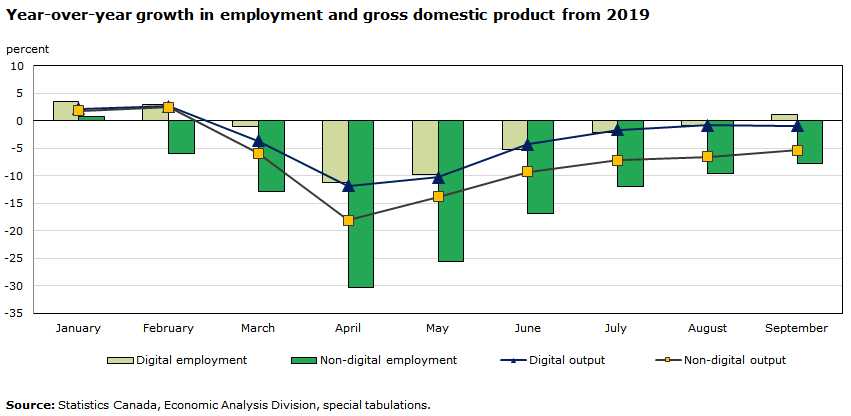
Data table
| January | February | March | April | May | June | July | August | September | |
|---|---|---|---|---|---|---|---|---|---|
| percent | |||||||||
| Digital employment | 3.5 | 3.0 | -1.1 | -11.3 | -9.7 | -5.2 | -2.2 | -0.8 | 1.1 |
| Non-digital employment | 0.7 | -5.9 | -12.9 | -30.2 | -25.6 | -16.9 | -11.9 | -9.6 | -7.8 |
| Digital output | 2.2 | 2.6 | -3.6 | -11.8 | -10.3 | -4.3 | -1.6 | -0.8 | -0.9 |
| Non-digital output | 1.8 | 2.5 | -5.9 | -18.1 | -13.8 | -9.3 | -7.2 | -6.5 | -5.4 |
| Source: Statistics Canada, Economic Analysis Division, special tabulations. | |||||||||
Impact of COVID-19 on automation
- Skills and activities that are complementary to automation, including non-routine cognitive analytical and interpersonal tasks, have become increasingly important to the working lives of Canadians.
- The more pronounced these skills are within the workforce, the less likely automation will lead to large-scale job transformation or job loss in the near term.
- The risk of automation-related job transformation varies widely across occupations and educational backgrounds. More than one-third of office support workers were at a high risk of job transformation, while those in professional and technical occupations faced little to no risk.
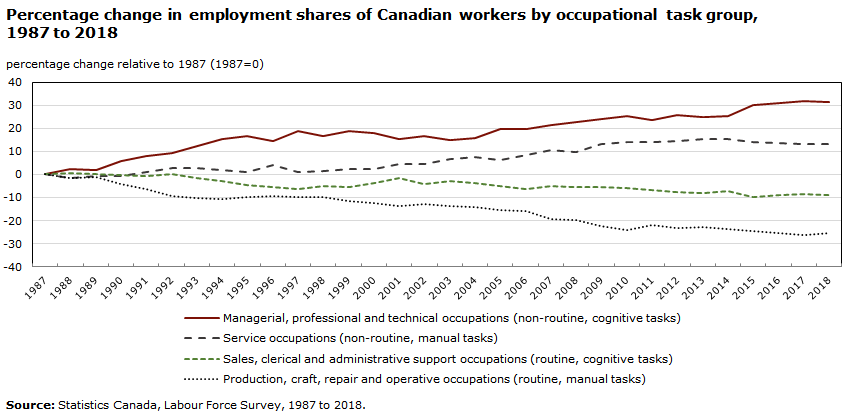
Data table
| Year | Managerial, professional and technical occupations (non-routine, cognitive tasks) | Service occupations (non-routine, manual tasks) | Sales, clerical and administrative support occupations (routine, cognitive tasks) | Production, craft, repair and operative occupations (routine, manual tasks) |
|---|---|---|---|---|
| percentage change relative to 1987 (1987=0) | ||||
| 1987 | 0 | 0 | 0 | 0 |
| 1988 | 2.36 | -1.35 | 0.73 | -1.68 |
| 1989 | 1.94 | -0.47 | 0.04 | -1.25 |
| 1990 | 6.02 | -0.78 | -0.26 | -4.08 |
| 1991 | 7.91 | 1.15 | -0.59 | -6.50 |
| 1992 | 9.51 | 2.60 | 0.07 | -9.33 |
| 1993 | 12.21 | 2.76 | -1.57 | -10.04 |
| 1994 | 15.24 | 1.77 | -2.78 | -10.74 |
| 1995 | 16.50 | 0.99 | -4.54 | -9.67 |
| 1996 | 14.44 | 4.01 | -5.38 | -9.16 |
| 1997 | 18.98 | 1.04 | -6.40 | -9.94 |
| 1998 | 16.88 | 1.35 | -4.83 | -9.90 |
| 1999 | 18.77 | 2.24 | -5.34 | -11.52 |
| 2000 | 18.01 | 2.45 | -3.88 | -12.39 |
| 2001 | 15.45 | 4.37 | -1.65 | -13.64 |
| 2002 | 16.88 | 4.69 | -4.02 | -12.80 |
| 2003 | 15.03 | 6.87 | -2.93 | -13.71 |
| 2004 | 15.78 | 7.65 | -3.84 | -14.01 |
| 2005 | 19.61 | 6.25 | -4.83 | -15.22 |
| 2006 | 19.91 | 8.59 | -6.29 | -15.66 |
| 2007 | 21.63 | 10.62 | -5.05 | -19.54 |
| 2008 | 22.81 | 9.73 | -5.23 | -19.70 |
| 2009 | 23.91 | 13.22 | -5.60 | -22.50 |
| 2010 | 25.46 | 14.06 | -5.96 | -23.95 |
| 2011 | 23.82 | 14.16 | -6.62 | -22.09 |
| 2012 | 25.76 | 14.68 | -7.50 | -23.17 |
| 2013 | 25.08 | 15.36 | -7.90 | -22.70 |
| 2014 | 25.46 | 15.30 | -7.14 | -23.71 |
| 2015 | 30.13 | 14.21 | -9.62 | -24.42 |
| 2016 | 31.02 | 13.74 | -8.93 | -25.50 |
| 2017 | 31.69 | 13.27 | -8.49 | -26.10 |
| 2018 | 31.40 | 13.22 | -9.07 | -25.29 |
| Source: Statistics Canada, Labour Force Survey, 1987 to 2018. | ||||
- A key issue: To what extent will the adoption of new business technologies affect workers?
Investing in robots and firm employment
- Research at Statistics Canada has found that investments in robotics have not been accompanied by mass layoffs—on the contrary, firms that invest in robots tend to be more productive and hire more workers.
- But robot-driven automation does affect the type of workers that businesses require, leading to increases in non-managerial employees and declines in the number of middle managers.
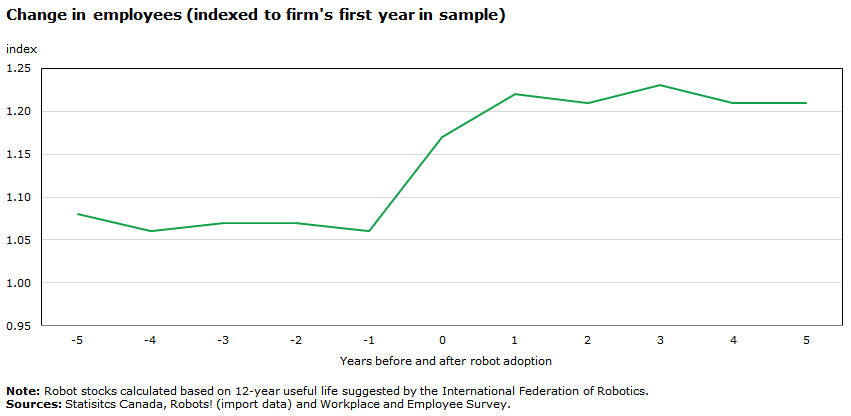
Data table
| Years before and after robot adoption | Change in employees (index) |
|---|---|
| -5 | 1.08 |
| -4 | 1.06 |
| -3 | 1.07 |
| -2 | 1.07 |
| -1 | 1.06 |
| 0 | 1.17 |
| 1 | 1.22 |
| 2 | 1.21 |
| 3 | 1.23 |
| 4 | 1.21 |
| 5 | 1.21 |
|
Note: Robot stocks calcualted based on 12-year useful life suggested by the International Federation of Robotics. Sources: Statisitcs Canada, Robots! (import data) and Workplace and Employee Survey. |
|
Capital plans in many industries were severely impacted by COVID-19, creating uncertainty around the key drivers of business investment
- Private sector capital intentions point to 5.6% increase in capital spending in 2021. However, planned private outlays are still down about 12% from spending levels prior to the pandemic.
- Major energy companies substantially revised their capital plans during the pandemic. 2021 capital intentions in mining and oil and gas extraction, at $32.9 billion, remain over 28% below pre-pandemic levels, while anticipated outlays in manufacturing, at $20.2 billion, are about 14% below.
- Planned capital spending in accommodation and food services, down 30% during 2020, is expected to fall an additional 27% in 2021 to just over one-half of pre-pandemic levels.
- A key issue: To what extent can new investment opportunities support a recovery in capital spending?

Data table
| Total | Private | Public | |
|---|---|---|---|
| index (2007 = 100) | |||
| 2007 | 100.0 | 100.0 | 100.0 |
| 2008 | 106.4 | 102.0 | 119.2 |
| 2009 | 91.6 | 80.5 | 124.1 |
| 2010 | 103.9 | 91.7 | 139.4 |
| 2011 | 112.0 | 103.8 | 135.8 |
| 2012 | 118.7 | 111.8 | 138.9 |
| 2013 | 121.9 | 117.3 | 135.4 |
| 2014 | 129.6 | 127.2 | 136.6 |
| 2015 | 119.7 | 110.9 | 145.5 |
| 2016 | 109.5 | 98.4 | 141.8 |
| 2017 | 114.3 | 99.8 | 156.3 |
| 2018 | 125.4 | 110.1 | 170.1 |
| 2019 | 130.4 | 116.1 | 172.1 |
| 2020 | 118.4 | 96.7 | 182.0 |
| 2021 | 126.8 | 102.0 | 198.9 |
|
Note: Data for 2021 are intentions; data for 2020 are preliminary actual estimates. Sources: Statistics Canada, Tables 34-10-0035-01 and 34-10-0037-01. |
|||
Investment in non-residential buildings declines while investment in housing is strengthened
While investment in residential construction has exceeded pre-pandemic levels, investment in non-residential construction has declined.
As of December 2020, total residential outlays, at $11.1 billion, were 8.1% above pre-pandemic levels. Spending on single-unit dwellings was up almost 14%.
New home prices rose 4.6% in 2020, as buyer preferences shifted toward larger single-family dwellings.
The surge in housing demand was supported by steady declines in mortgage interest costs, as borrowing rebounded following the lockdowns.
As of December 2020, total investment in non-residential buildings was 13% below pre-pandemic levels.
Spending on commercial buildings was down 17% from levels observed in February 2020, while spending on industrial buildings was down 11%.

Data table
| Month | Residential | Non-residential |
|---|---|---|
| index (February 2020=100) | ||
| January | 98.3 | 98.8 |
| February | 100.0 | 100.0 |
| March | 98.1 | 95.7 |
| April | 50.8 | 58.5 |
| May | 82.3 | 96.4 |
| June | 93.1 | 106.9 |
| July | 97.0 | 102.4 |
| August | 103.1 | 97.8 |
| September | 105.0 | 89.8 |
| October | 106.2 | 87.2 |
| November | 106.1 | 87.1 |
| December | 108.1 | 87.4 |
| Source: Statistics Canada, Table 34-10-0175-01. | ||
Growth in environmental and clean technology products accelerated before the pandemic
- In 2019, the ECTP sector grew at nearly twice the pace of the economy as a whole and accounted for 3% of Canada’s GDP.

Data table
| Canada GDP growth | ECTP growth | |
|---|---|---|
| percent | ||
| 2013 | 2.3 | 5.9 |
| 2014 | 2.9 | 4.5 |
| 2015 | 0.7 | 5.5 |
| 2016 | 1.0 | 2.0 |
| 2017 | 3.0 | -0.4 |
| 2018 | 2.4 | 1.5 |
| 2019 | 1.9 | 3.5 |
|
Notes: GDP = gross domestic product; ECTP = environmental and clean technology product. Sources: Statistics Canada, tables 36-10-0222-01 and 36-10-0630-01. |
||
- Environmental and clean technology activity accounted for 341,000 jobs in 2019, about 1.8% of all jobs in Canada.

Data table
| Utilities | Engineering construction | Manufacturing | Professional, scientific and technical services | Administrative and support, waste management and remediation services | Other industries | |
|---|---|---|---|---|---|---|
| percent | ||||||
| 2019 | 22.0 | 18.9 | 11.8 | 15.3 | 14.5 | 17.6 |
| Source: Statistics Canada, Table 36-10-0632-01. | ||||||
- A key issue: Going forward, will investment in new ECTPs provide reasonable stimulus for job and income growth?
Want to know more?
To learn more about the economic impacts of COVID-19, see Economic impacts and recovery related to the pandemic in The Social and Economic Impacts of COVID-19: A Six-month Update.
Related articles:
Gross domestic product, income and expenditure, fourth quarter 2020 and Gross domestic product by industry, December 2020
Monthly estimates of business openings and closures, November 2020
Experimental indexes of economic activity in the provinces and territories, October 2020
THE PATH FORWARD – WHAT WILL DRIVE CANADA'S RECOVERY?

Several themes are likely to influence Canada's recovery from the pandemic.
- Overcoming vaccine hesitance and finding ways to measure how close we are to herd immunity.
- Determining where and what support is needed based on the rich, disaggregated data provided by the 2021 Census of Population, and continued enhancements to other surveys such as the Labour Force Survey (LFS).
- Understanding the impact on Canada and Canadians of COVID-19 – StatCan has published nearly 100 papers and articles on this since the beginning of the pandemic.
- Prioritizing the development of user-centric analysis tools to support those actively monitoring the pandemic’s impact.
- Expanding our understanding of varying socio-economic impact through such tools as the geospatial explorer.
STATISTICS CANADA – AREAS OF FOCUS

Governments, businesses, media and the general population will rely on Statistics Canada’s ongoing portrait of the recovery.
- Promoting and encouraging completion of 2021 Census of Population and Census of Agriculture.
- Continuing to pursue and strengthen partnerships and new resources.
- Leveraging data assets to ensure optimal use and value while maintaining public trust.
- Monitoring and measuring continued concerns over mental and physical health.
- Ensuring openness and transparency while protecting privacy and confidentiality.
- Strengthening our position as Canada’s authoritative and independent source of data and insights.
- Date modified:
